Indigenous Knowledges and Western Knowledges in Environmental Education
VerifiedAdded on 2023/04/23
|16
|8522
|406
AI Summary
This paper explores the differences between Indigenous and Western worldviews in relation to the environment/land and argues for a "two-worlds" approach in environmental education that engages both Indigenous and Western knowledges.
Contribute Materials
Your contribution can guide someone’s learning journey. Share your
documents today.
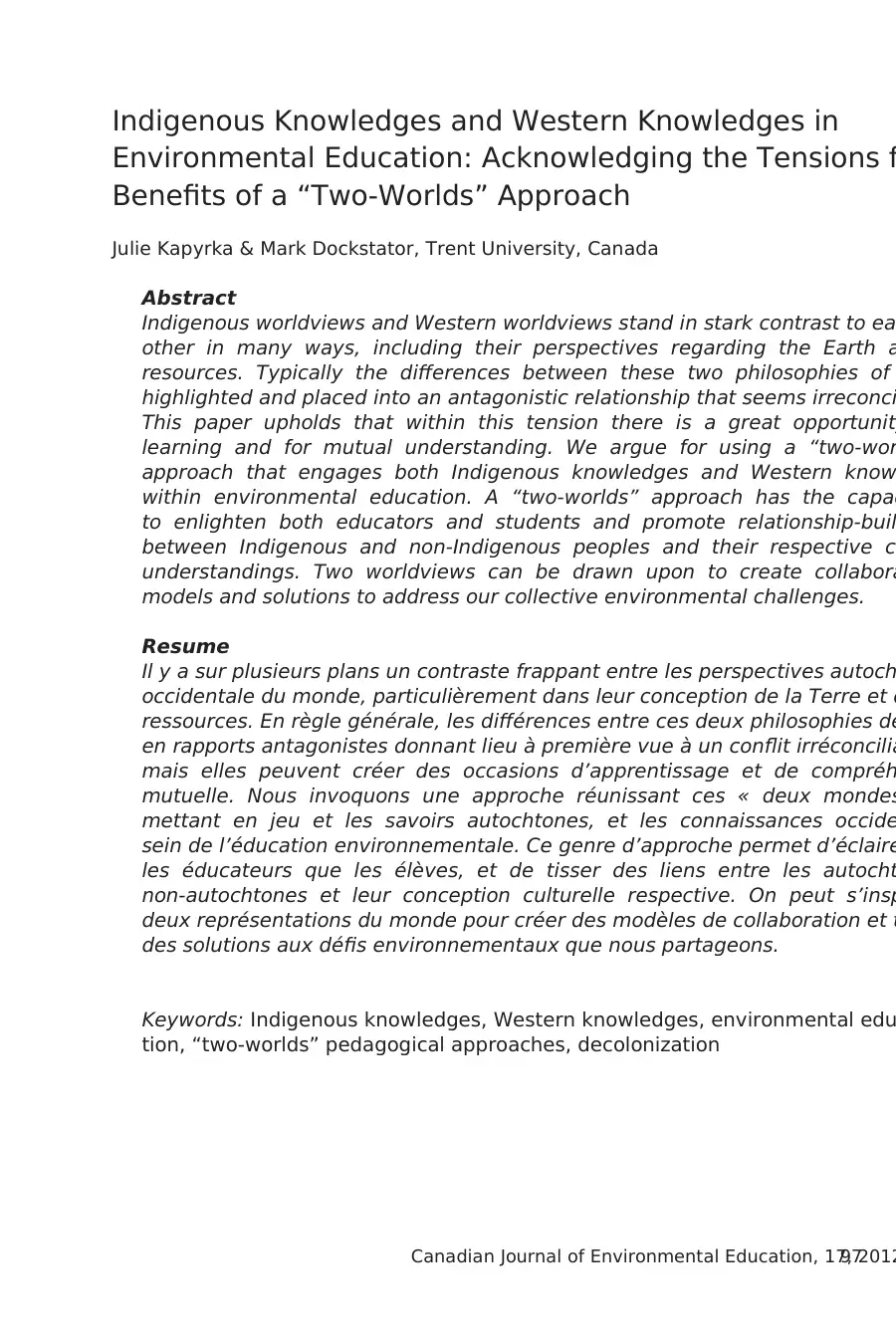
97Canadian Journal of Environmental Education, 17, 2012
Indigenous Knowledges and Western Knowledges in
Environmental Education: Acknowledging the Tensions f
Benefits of a “Two-Worlds” Approach
Julie Kapyrka & Mark Dockstator, Trent University, Canada
Abstract
Indigenous worldviews and Western worldviews stand in stark contrast to ea
other in many ways, including their perspectives regarding the Earth a
resources. Typically the differences between these two philosophies of
highlighted and placed into an antagonistic relationship that seems irreconci
This paper upholds that within this tension there is a great opportunity
learning and for mutual understanding. We argue for using a “two-wor
approach that engages both Indigenous knowledges and Western know
within environmental education. A “two-worlds” approach has the capac
to enlighten both educators and students and promote relationship-buil
between Indigenous and non-Indigenous peoples and their respective cu
understandings. Two worldviews can be drawn upon to create collabora
models and solutions to address our collective environmental challenges.
Resume
Il y a sur plusieurs plans un contraste frappant entre les perspectives autoch
occidentale du monde, particulièrement dans leur conception de la Terre et d
ressources. En règle générale, les différences entre ces deux philosophies dé
en rapports antagonistes donnant lieu à première vue à un conflit irréconcilia
mais elles peuvent créer des occasions d’apprentissage et de compréh
mutuelle. Nous invoquons une approche réunissant ces « deux mondes
mettant en jeu et les savoirs autochtones, et les connaissances occide
sein de l’éducation environnementale. Ce genre d’approche permet d’éclaire
les éducateurs que les élèves, et de tisser des liens entre les autocht
non-autochtones et leur conception culturelle respective. On peut s’insp
deux représentations du monde pour créer des modèles de collaboration et t
des solutions aux défis environnementaux que nous partageons.
Keywords: Indigenous knowledges, Western knowledges, environmental edu
tion, “two-worlds” pedagogical approaches, decolonization
Indigenous Knowledges and Western Knowledges in
Environmental Education: Acknowledging the Tensions f
Benefits of a “Two-Worlds” Approach
Julie Kapyrka & Mark Dockstator, Trent University, Canada
Abstract
Indigenous worldviews and Western worldviews stand in stark contrast to ea
other in many ways, including their perspectives regarding the Earth a
resources. Typically the differences between these two philosophies of
highlighted and placed into an antagonistic relationship that seems irreconci
This paper upholds that within this tension there is a great opportunity
learning and for mutual understanding. We argue for using a “two-wor
approach that engages both Indigenous knowledges and Western know
within environmental education. A “two-worlds” approach has the capac
to enlighten both educators and students and promote relationship-buil
between Indigenous and non-Indigenous peoples and their respective cu
understandings. Two worldviews can be drawn upon to create collabora
models and solutions to address our collective environmental challenges.
Resume
Il y a sur plusieurs plans un contraste frappant entre les perspectives autoch
occidentale du monde, particulièrement dans leur conception de la Terre et d
ressources. En règle générale, les différences entre ces deux philosophies dé
en rapports antagonistes donnant lieu à première vue à un conflit irréconcilia
mais elles peuvent créer des occasions d’apprentissage et de compréh
mutuelle. Nous invoquons une approche réunissant ces « deux mondes
mettant en jeu et les savoirs autochtones, et les connaissances occide
sein de l’éducation environnementale. Ce genre d’approche permet d’éclaire
les éducateurs que les élèves, et de tisser des liens entre les autocht
non-autochtones et leur conception culturelle respective. On peut s’insp
deux représentations du monde pour créer des modèles de collaboration et t
des solutions aux défis environnementaux que nous partageons.
Keywords: Indigenous knowledges, Western knowledges, environmental edu
tion, “two-worlds” pedagogical approaches, decolonization
Secure Best Marks with AI Grader
Need help grading? Try our AI Grader for instant feedback on your assignments.
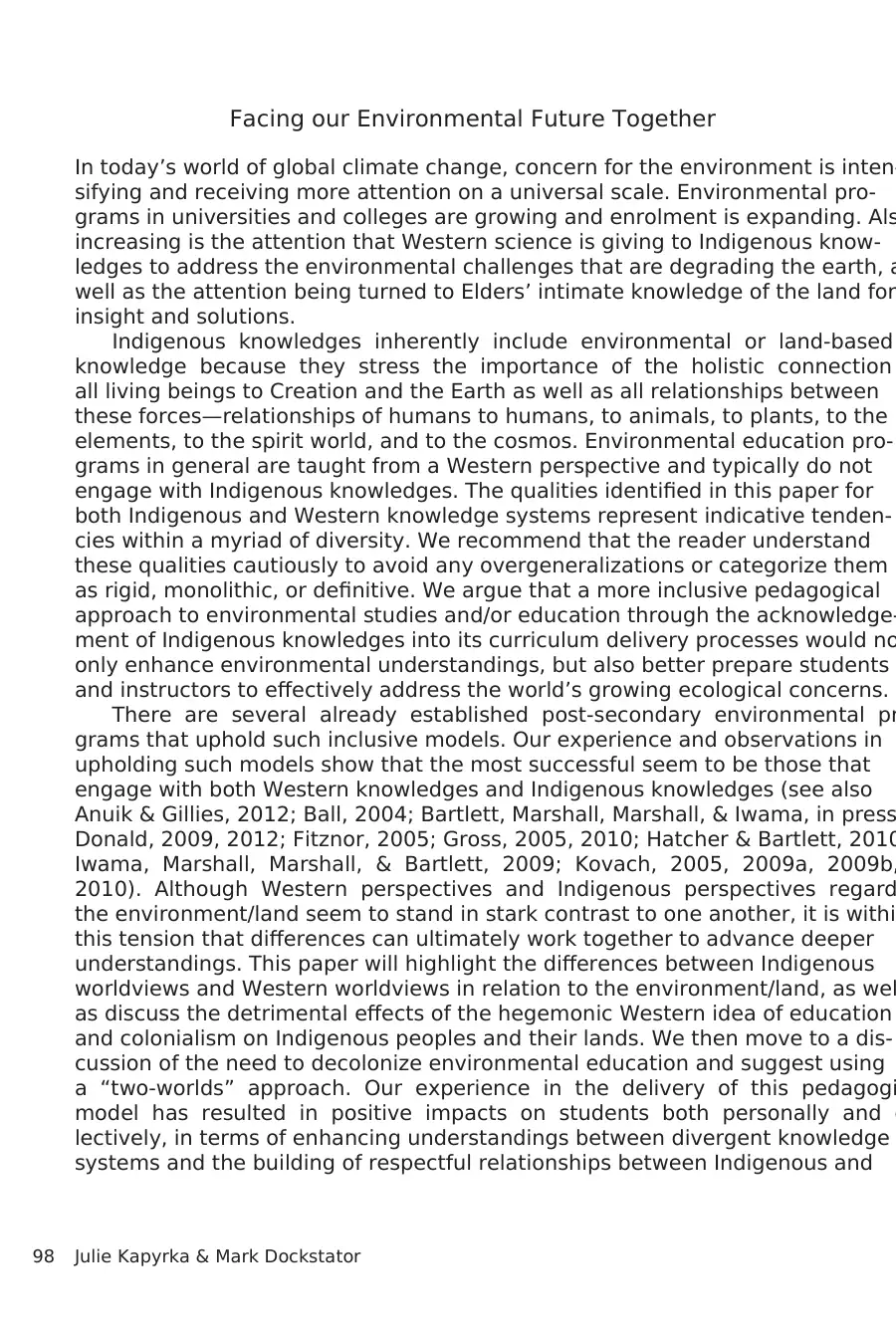
98 Julie Kapyrka & Mark Dockstator
Facing our Environmental Future Together
In today’s world of global climate change, concern for the environment is inten-
sifying and receiving more attention on a universal scale. Environmental pro-
grams in universities and colleges are growing and enrolment is expanding. Als
increasing is the attention that Western science is giving to Indigenous know-
ledges to address the environmental challenges that are degrading the earth, a
well as the attention being turned to Elders’ intimate knowledge of the land for
insight and solutions.
Indigenous knowledges inherently include environmental or land-based
knowledge because they stress the importance of the holistic connection
all living beings to Creation and the Earth as well as all relationships between
these forces—relationships of humans to humans, to animals, to plants, to the
elements, to the spirit world, and to the cosmos. Environmental education pro-
grams in general are taught from a Western perspective and typically do not
engage with Indigenous knowledges. The qualities identified in this paper for
both Indigenous and Western knowledge systems represent indicative tenden-
cies within a myriad of diversity. We recommend that the reader understand
these qualities cautiously to avoid any overgeneralizations or categorize them
as rigid, monolithic, or definitive. We argue that a more inclusive pedagogical
approach to environmental studies and/or education through the acknowledge-
ment of Indigenous knowledges into its curriculum delivery processes would no
only enhance environmental understandings, but also better prepare students
and instructors to effectively address the world’s growing ecological concerns.
There are several already established post-secondary environmental pr
grams that uphold such inclusive models. Our experience and observations in
upholding such models show that the most successful seem to be those that
engage with both Western knowledges and Indigenous knowledges (see also
Anuik & Gillies, 2012; Ball, 2004; Bartlett, Marshall, Marshall, & Iwama, in press
Donald, 2009, 2012; Fitznor, 2005; Gross, 2005, 2010; Hatcher & Bartlett, 2010
Iwama, Marshall, Marshall, & Bartlett, 2009; Kovach, 2005, 2009a, 2009b,
2010). Although Western perspectives and Indigenous perspectives regard
the environment/land seem to stand in stark contrast to one another, it is within
this tension that differences can ultimately work together to advance deeper
understandings. This paper will highlight the differences between Indigenous
worldviews and Western worldviews in relation to the environment/land, as wel
as discuss the detrimental effects of the hegemonic Western idea of education
and colonialism on Indigenous peoples and their lands. We then move to a dis-
cussion of the need to decolonize environmental education and suggest using
a “two-worlds” approach. Our experience in the delivery of this pedagogi
model has resulted in positive impacts on students both personally and c
lectively, in terms of enhancing understandings between divergent knowledge
systems and the building of respectful relationships between Indigenous and
Facing our Environmental Future Together
In today’s world of global climate change, concern for the environment is inten-
sifying and receiving more attention on a universal scale. Environmental pro-
grams in universities and colleges are growing and enrolment is expanding. Als
increasing is the attention that Western science is giving to Indigenous know-
ledges to address the environmental challenges that are degrading the earth, a
well as the attention being turned to Elders’ intimate knowledge of the land for
insight and solutions.
Indigenous knowledges inherently include environmental or land-based
knowledge because they stress the importance of the holistic connection
all living beings to Creation and the Earth as well as all relationships between
these forces—relationships of humans to humans, to animals, to plants, to the
elements, to the spirit world, and to the cosmos. Environmental education pro-
grams in general are taught from a Western perspective and typically do not
engage with Indigenous knowledges. The qualities identified in this paper for
both Indigenous and Western knowledge systems represent indicative tenden-
cies within a myriad of diversity. We recommend that the reader understand
these qualities cautiously to avoid any overgeneralizations or categorize them
as rigid, monolithic, or definitive. We argue that a more inclusive pedagogical
approach to environmental studies and/or education through the acknowledge-
ment of Indigenous knowledges into its curriculum delivery processes would no
only enhance environmental understandings, but also better prepare students
and instructors to effectively address the world’s growing ecological concerns.
There are several already established post-secondary environmental pr
grams that uphold such inclusive models. Our experience and observations in
upholding such models show that the most successful seem to be those that
engage with both Western knowledges and Indigenous knowledges (see also
Anuik & Gillies, 2012; Ball, 2004; Bartlett, Marshall, Marshall, & Iwama, in press
Donald, 2009, 2012; Fitznor, 2005; Gross, 2005, 2010; Hatcher & Bartlett, 2010
Iwama, Marshall, Marshall, & Bartlett, 2009; Kovach, 2005, 2009a, 2009b,
2010). Although Western perspectives and Indigenous perspectives regard
the environment/land seem to stand in stark contrast to one another, it is within
this tension that differences can ultimately work together to advance deeper
understandings. This paper will highlight the differences between Indigenous
worldviews and Western worldviews in relation to the environment/land, as wel
as discuss the detrimental effects of the hegemonic Western idea of education
and colonialism on Indigenous peoples and their lands. We then move to a dis-
cussion of the need to decolonize environmental education and suggest using
a “two-worlds” approach. Our experience in the delivery of this pedagogi
model has resulted in positive impacts on students both personally and c
lectively, in terms of enhancing understandings between divergent knowledge
systems and the building of respectful relationships between Indigenous and
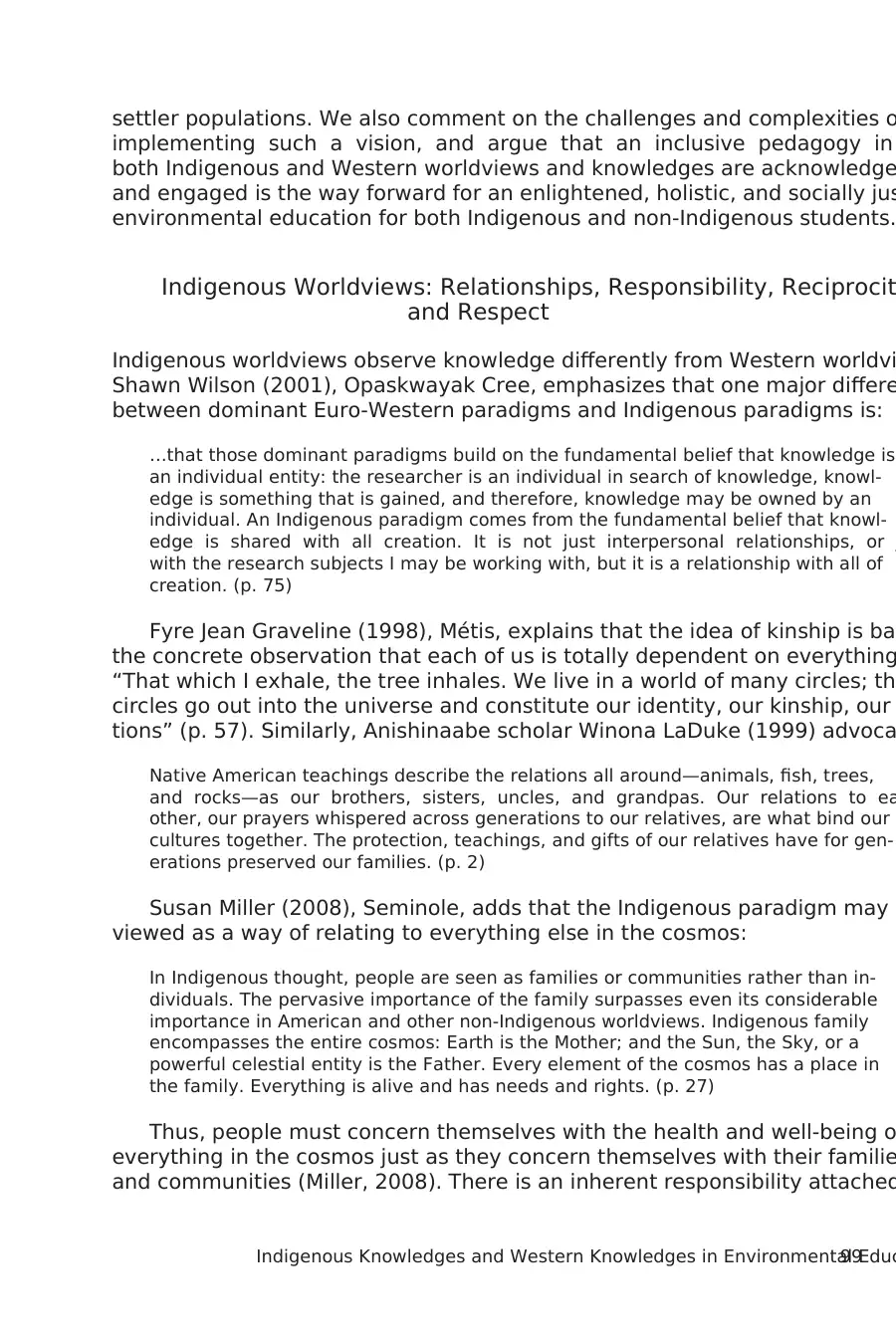
99Indigenous Knowledges and Western Knowledges in Environmental Educ
settler populations. We also comment on the challenges and complexities o
implementing such a vision, and argue that an inclusive pedagogy in
both Indigenous and Western worldviews and knowledges are acknowledge
and engaged is the way forward for an enlightened, holistic, and socially jus
environmental education for both Indigenous and non-Indigenous students.
Indigenous Worldviews: Relationships, Responsibility, Reciprocit
and Respect
Indigenous worldviews observe knowledge differently from Western worldvi
Shawn Wilson (2001), Opaskwayak Cree, emphasizes that one major differe
between dominant Euro-Western paradigms and Indigenous paradigms is:
…that those dominant paradigms build on the fundamental belief that knowledge is
an individual entity: the researcher is an individual in search of knowledge, knowl-
edge is something that is gained, and therefore, knowledge may be owned by an
individual. An Indigenous paradigm comes from the fundamental belief that knowl-
edge is shared with all creation. It is not just interpersonal relationships, or j
with the research subjects I may be working with, but it is a relationship with all of
creation. (p. 75)
Fyre Jean Graveline (1998), Métis, explains that the idea of kinship is bas
the concrete observation that each of us is totally dependent on everything
“That which I exhale, the tree inhales. We live in a world of many circles; the
circles go out into the universe and constitute our identity, our kinship, our
tions” (p. 57). Similarly, Anishinaabe scholar Winona LaDuke (1999) advoca
Native American teachings describe the relations all around—animals, fish, trees,
and rocks—as our brothers, sisters, uncles, and grandpas. Our relations to ea
other, our prayers whispered across generations to our relatives, are what bind our
cultures together. The protection, teachings, and gifts of our relatives have for gen-
erations preserved our families. (p. 2)
Susan Miller (2008), Seminole, adds that the Indigenous paradigm may b
viewed as a way of relating to everything else in the cosmos:
In Indigenous thought, people are seen as families or communities rather than in-
dividuals. The pervasive importance of the family surpasses even its considerable
importance in American and other non-Indigenous worldviews. Indigenous family
encompasses the entire cosmos: Earth is the Mother; and the Sun, the Sky, or a
powerful celestial entity is the Father. Every element of the cosmos has a place in
the family. Everything is alive and has needs and rights. (p. 27)
Thus, people must concern themselves with the health and well-being o
everything in the cosmos just as they concern themselves with their familie
and communities (Miller, 2008). There is an inherent responsibility attached
settler populations. We also comment on the challenges and complexities o
implementing such a vision, and argue that an inclusive pedagogy in
both Indigenous and Western worldviews and knowledges are acknowledge
and engaged is the way forward for an enlightened, holistic, and socially jus
environmental education for both Indigenous and non-Indigenous students.
Indigenous Worldviews: Relationships, Responsibility, Reciprocit
and Respect
Indigenous worldviews observe knowledge differently from Western worldvi
Shawn Wilson (2001), Opaskwayak Cree, emphasizes that one major differe
between dominant Euro-Western paradigms and Indigenous paradigms is:
…that those dominant paradigms build on the fundamental belief that knowledge is
an individual entity: the researcher is an individual in search of knowledge, knowl-
edge is something that is gained, and therefore, knowledge may be owned by an
individual. An Indigenous paradigm comes from the fundamental belief that knowl-
edge is shared with all creation. It is not just interpersonal relationships, or j
with the research subjects I may be working with, but it is a relationship with all of
creation. (p. 75)
Fyre Jean Graveline (1998), Métis, explains that the idea of kinship is bas
the concrete observation that each of us is totally dependent on everything
“That which I exhale, the tree inhales. We live in a world of many circles; the
circles go out into the universe and constitute our identity, our kinship, our
tions” (p. 57). Similarly, Anishinaabe scholar Winona LaDuke (1999) advoca
Native American teachings describe the relations all around—animals, fish, trees,
and rocks—as our brothers, sisters, uncles, and grandpas. Our relations to ea
other, our prayers whispered across generations to our relatives, are what bind our
cultures together. The protection, teachings, and gifts of our relatives have for gen-
erations preserved our families. (p. 2)
Susan Miller (2008), Seminole, adds that the Indigenous paradigm may b
viewed as a way of relating to everything else in the cosmos:
In Indigenous thought, people are seen as families or communities rather than in-
dividuals. The pervasive importance of the family surpasses even its considerable
importance in American and other non-Indigenous worldviews. Indigenous family
encompasses the entire cosmos: Earth is the Mother; and the Sun, the Sky, or a
powerful celestial entity is the Father. Every element of the cosmos has a place in
the family. Everything is alive and has needs and rights. (p. 27)
Thus, people must concern themselves with the health and well-being o
everything in the cosmos just as they concern themselves with their familie
and communities (Miller, 2008). There is an inherent responsibility attached
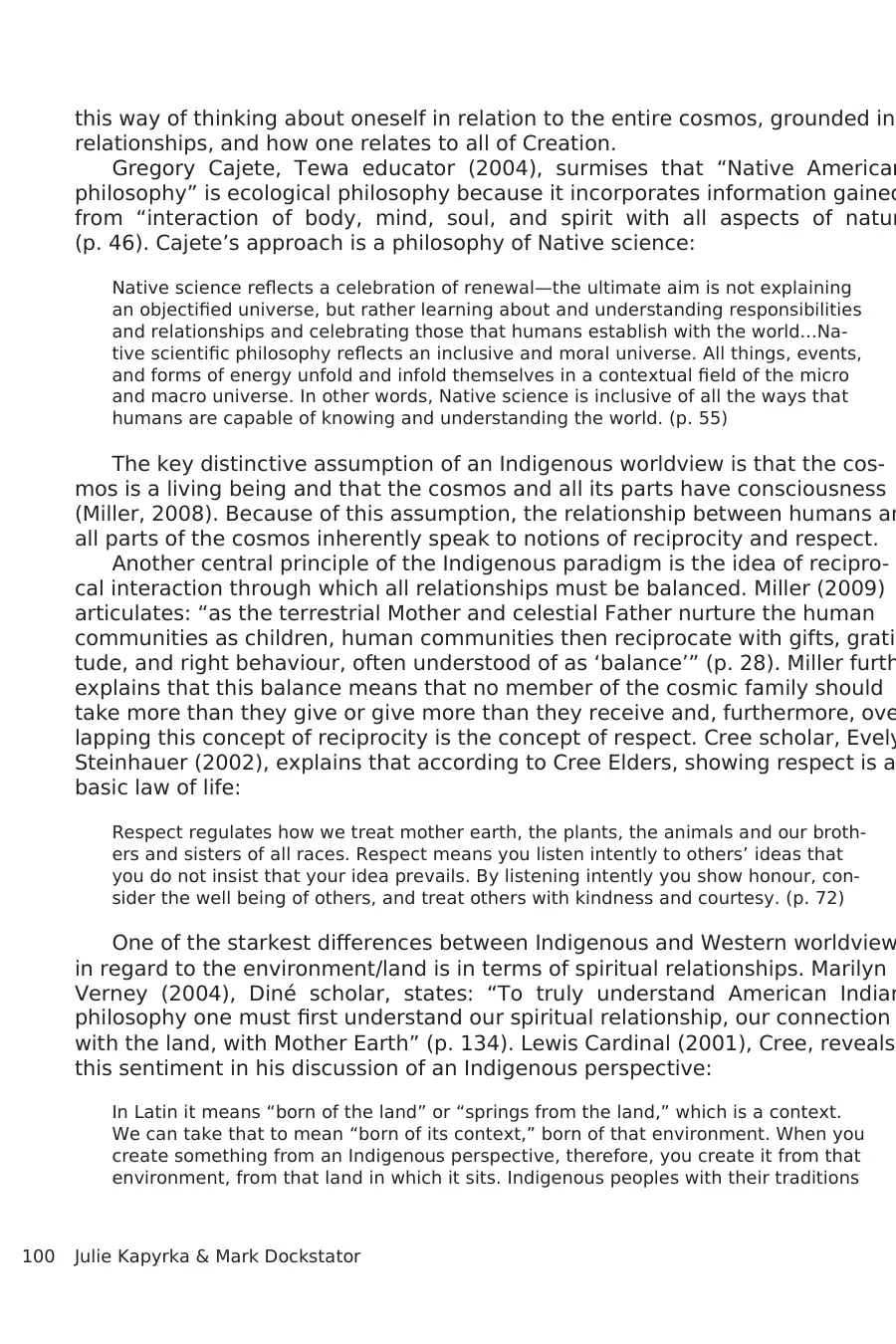
100 Julie Kapyrka & Mark Dockstator
this way of thinking about oneself in relation to the entire cosmos, grounded in
relationships, and how one relates to all of Creation.
Gregory Cajete, Tewa educator (2004), surmises that “Native American
philosophy” is ecological philosophy because it incorporates information gained
from “interaction of body, mind, soul, and spirit with all aspects of natur
(p. 46). Cajete’s approach is a philosophy of Native science:
Native science reflects a celebration of renewal—the ultimate aim is not explaining
an objectified universe, but rather learning about and understanding responsibilities
and relationships and celebrating those that humans establish with the world...Na-
tive scientific philosophy reflects an inclusive and moral universe. All things, events,
and forms of energy unfold and infold themselves in a contextual field of the micro
and macro universe. In other words, Native science is inclusive of all the ways that
humans are capable of knowing and understanding the world. (p. 55)
The key distinctive assumption of an Indigenous worldview is that the cos-
mos is a living being and that the cosmos and all its parts have consciousness
(Miller, 2008). Because of this assumption, the relationship between humans an
all parts of the cosmos inherently speak to notions of reciprocity and respect.
Another central principle of the Indigenous paradigm is the idea of recipro-
cal interaction through which all relationships must be balanced. Miller (2009)
articulates: “as the terrestrial Mother and celestial Father nurture the human
communities as children, human communities then reciprocate with gifts, grati-
tude, and right behaviour, often understood of as ‘balance’” (p. 28). Miller furth
explains that this balance means that no member of the cosmic family should
take more than they give or give more than they receive and, furthermore, ove
lapping this concept of reciprocity is the concept of respect. Cree scholar, Evely
Steinhauer (2002), explains that according to Cree Elders, showing respect is a
basic law of life:
Respect regulates how we treat mother earth, the plants, the animals and our broth-
ers and sisters of all races. Respect means you listen intently to others’ ideas that
you do not insist that your idea prevails. By listening intently you show honour, con-
sider the well being of others, and treat others with kindness and courtesy. (p. 72)
One of the starkest differences between Indigenous and Western worldview
in regard to the environment/land is in terms of spiritual relationships. Marilyn
Verney (2004), Diné scholar, states: “To truly understand American Indian
philosophy one must first understand our spiritual relationship, our connection
with the land, with Mother Earth” (p. 134). Lewis Cardinal (2001), Cree, reveals
this sentiment in his discussion of an Indigenous perspective:
In Latin it means “born of the land” or “springs from the land,” which is a context.
We can take that to mean “born of its context,” born of that environment. When you
create something from an Indigenous perspective, therefore, you create it from that
environment, from that land in which it sits. Indigenous peoples with their traditions
this way of thinking about oneself in relation to the entire cosmos, grounded in
relationships, and how one relates to all of Creation.
Gregory Cajete, Tewa educator (2004), surmises that “Native American
philosophy” is ecological philosophy because it incorporates information gained
from “interaction of body, mind, soul, and spirit with all aspects of natur
(p. 46). Cajete’s approach is a philosophy of Native science:
Native science reflects a celebration of renewal—the ultimate aim is not explaining
an objectified universe, but rather learning about and understanding responsibilities
and relationships and celebrating those that humans establish with the world...Na-
tive scientific philosophy reflects an inclusive and moral universe. All things, events,
and forms of energy unfold and infold themselves in a contextual field of the micro
and macro universe. In other words, Native science is inclusive of all the ways that
humans are capable of knowing and understanding the world. (p. 55)
The key distinctive assumption of an Indigenous worldview is that the cos-
mos is a living being and that the cosmos and all its parts have consciousness
(Miller, 2008). Because of this assumption, the relationship between humans an
all parts of the cosmos inherently speak to notions of reciprocity and respect.
Another central principle of the Indigenous paradigm is the idea of recipro-
cal interaction through which all relationships must be balanced. Miller (2009)
articulates: “as the terrestrial Mother and celestial Father nurture the human
communities as children, human communities then reciprocate with gifts, grati-
tude, and right behaviour, often understood of as ‘balance’” (p. 28). Miller furth
explains that this balance means that no member of the cosmic family should
take more than they give or give more than they receive and, furthermore, ove
lapping this concept of reciprocity is the concept of respect. Cree scholar, Evely
Steinhauer (2002), explains that according to Cree Elders, showing respect is a
basic law of life:
Respect regulates how we treat mother earth, the plants, the animals and our broth-
ers and sisters of all races. Respect means you listen intently to others’ ideas that
you do not insist that your idea prevails. By listening intently you show honour, con-
sider the well being of others, and treat others with kindness and courtesy. (p. 72)
One of the starkest differences between Indigenous and Western worldview
in regard to the environment/land is in terms of spiritual relationships. Marilyn
Verney (2004), Diné scholar, states: “To truly understand American Indian
philosophy one must first understand our spiritual relationship, our connection
with the land, with Mother Earth” (p. 134). Lewis Cardinal (2001), Cree, reveals
this sentiment in his discussion of an Indigenous perspective:
In Latin it means “born of the land” or “springs from the land,” which is a context.
We can take that to mean “born of its context,” born of that environment. When you
create something from an Indigenous perspective, therefore, you create it from that
environment, from that land in which it sits. Indigenous peoples with their traditions
Paraphrase This Document
Need a fresh take? Get an instant paraphrase of this document with our AI Paraphraser
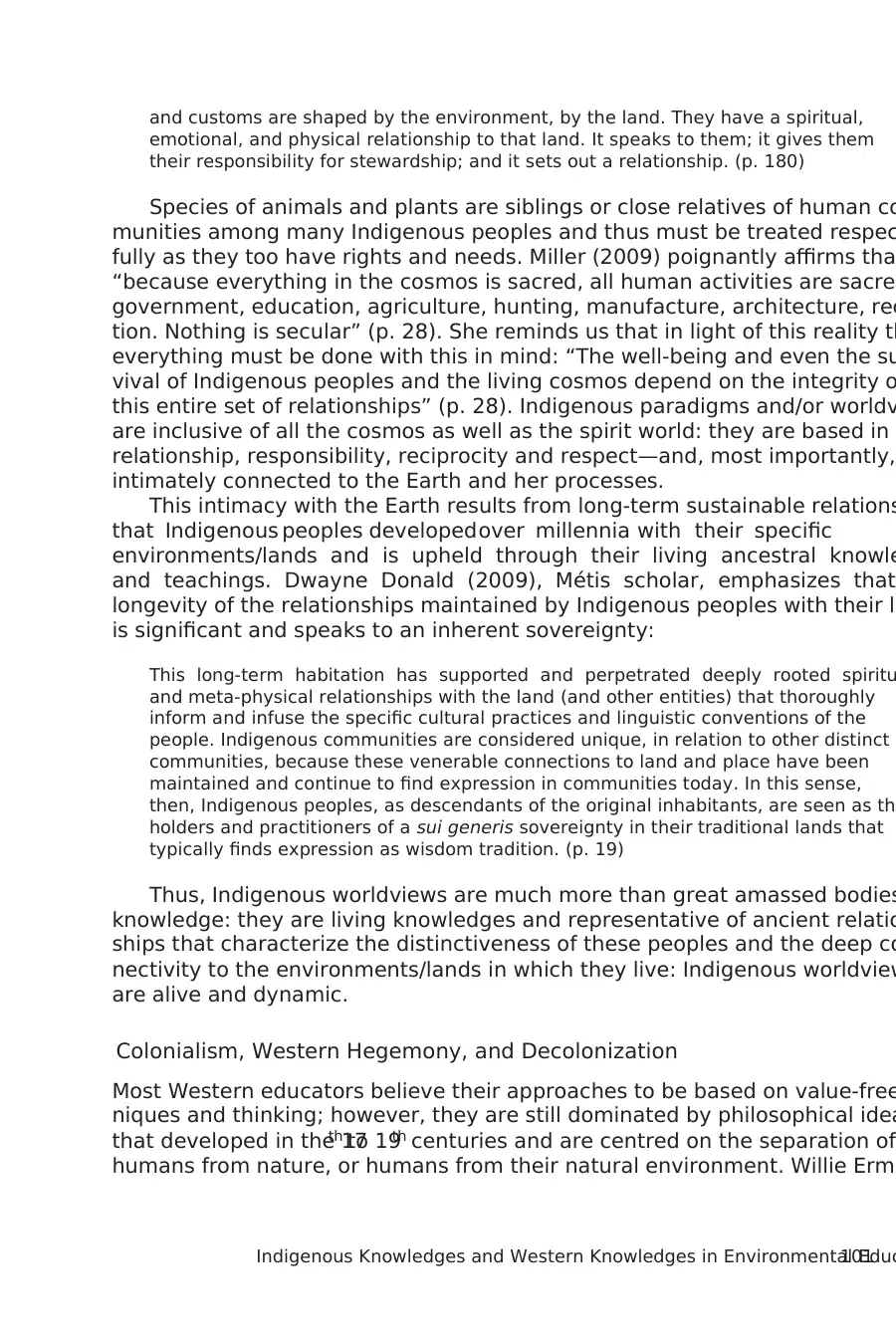
101Indigenous Knowledges and Western Knowledges in Environmental Educ
and customs are shaped by the environment, by the land. They have a spiritual,
emotional, and physical relationship to that land. It speaks to them; it gives them
their responsibility for stewardship; and it sets out a relationship. (p. 180)
Species of animals and plants are siblings or close relatives of human co
munities among many Indigenous peoples and thus must be treated respec
fully as they too have rights and needs. Miller (2009) poignantly affirms tha
“because everything in the cosmos is sacred, all human activities are sacred
government, education, agriculture, hunting, manufacture, architecture, rec
tion. Nothing is secular” (p. 28). She reminds us that in light of this reality th
everything must be done with this in mind: “The well-being and even the su
vival of Indigenous peoples and the living cosmos depend on the integrity o
this entire set of relationships” (p. 28). Indigenous paradigms and/or worldv
are inclusive of all the cosmos as well as the spirit world: they are based in
relationship, responsibility, reciprocity and respect—and, most importantly,
intimately connected to the Earth and her processes.
This intimacy with the Earth results from long-term sustainable relations
that Indigenous peoples developed over millennia with their specific
environments/lands and is upheld through their living ancestral knowle
and teachings. Dwayne Donald (2009), Métis scholar, emphasizes that
longevity of the relationships maintained by Indigenous peoples with their la
is significant and speaks to an inherent sovereignty:
This long-term habitation has supported and perpetrated deeply rooted spiritu
and meta-physical relationships with the land (and other entities) that thoroughly
inform and infuse the specific cultural practices and linguistic conventions of the
people. Indigenous communities are considered unique, in relation to other distinct
communities, because these venerable connections to land and place have been
maintained and continue to find expression in communities today. In this sense,
then, Indigenous peoples, as descendants of the original inhabitants, are seen as the
holders and practitioners of a sui generis sovereignty in their traditional lands that
typically finds expression as wisdom tradition. (p. 19)
Thus, Indigenous worldviews are much more than great amassed bodies
knowledge: they are living knowledges and representative of ancient relatio
ships that characterize the distinctiveness of these peoples and the deep co
nectivity to the environments/lands in which they live: Indigenous worldview
are alive and dynamic.
Colonialism, Western Hegemony, and Decolonization
Most Western educators believe their approaches to be based on value-free
niques and thinking; however, they are still dominated by philosophical idea
that developed in the 17th to 19th centuries and are centred on the separation of
humans from nature, or humans from their natural environment. Willie Ermi
and customs are shaped by the environment, by the land. They have a spiritual,
emotional, and physical relationship to that land. It speaks to them; it gives them
their responsibility for stewardship; and it sets out a relationship. (p. 180)
Species of animals and plants are siblings or close relatives of human co
munities among many Indigenous peoples and thus must be treated respec
fully as they too have rights and needs. Miller (2009) poignantly affirms tha
“because everything in the cosmos is sacred, all human activities are sacred
government, education, agriculture, hunting, manufacture, architecture, rec
tion. Nothing is secular” (p. 28). She reminds us that in light of this reality th
everything must be done with this in mind: “The well-being and even the su
vival of Indigenous peoples and the living cosmos depend on the integrity o
this entire set of relationships” (p. 28). Indigenous paradigms and/or worldv
are inclusive of all the cosmos as well as the spirit world: they are based in
relationship, responsibility, reciprocity and respect—and, most importantly,
intimately connected to the Earth and her processes.
This intimacy with the Earth results from long-term sustainable relations
that Indigenous peoples developed over millennia with their specific
environments/lands and is upheld through their living ancestral knowle
and teachings. Dwayne Donald (2009), Métis scholar, emphasizes that
longevity of the relationships maintained by Indigenous peoples with their la
is significant and speaks to an inherent sovereignty:
This long-term habitation has supported and perpetrated deeply rooted spiritu
and meta-physical relationships with the land (and other entities) that thoroughly
inform and infuse the specific cultural practices and linguistic conventions of the
people. Indigenous communities are considered unique, in relation to other distinct
communities, because these venerable connections to land and place have been
maintained and continue to find expression in communities today. In this sense,
then, Indigenous peoples, as descendants of the original inhabitants, are seen as the
holders and practitioners of a sui generis sovereignty in their traditional lands that
typically finds expression as wisdom tradition. (p. 19)
Thus, Indigenous worldviews are much more than great amassed bodies
knowledge: they are living knowledges and representative of ancient relatio
ships that characterize the distinctiveness of these peoples and the deep co
nectivity to the environments/lands in which they live: Indigenous worldview
are alive and dynamic.
Colonialism, Western Hegemony, and Decolonization
Most Western educators believe their approaches to be based on value-free
niques and thinking; however, they are still dominated by philosophical idea
that developed in the 17th to 19th centuries and are centred on the separation of
humans from nature, or humans from their natural environment. Willie Ermi
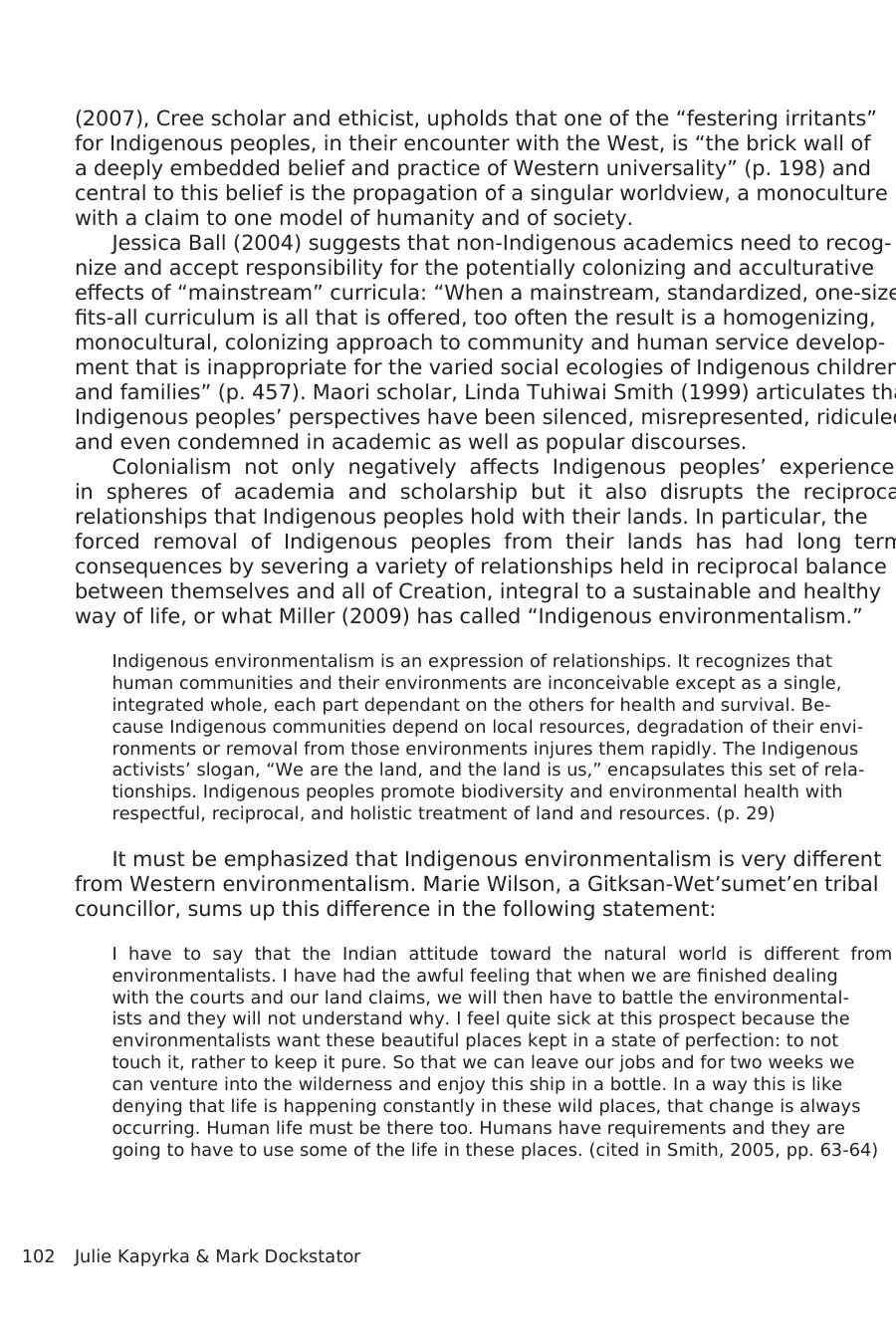
102 Julie Kapyrka & Mark Dockstator
(2007), Cree scholar and ethicist, upholds that one of the “festering irritants”
for Indigenous peoples, in their encounter with the West, is “the brick wall of
a deeply embedded belief and practice of Western universality” (p. 198) and
central to this belief is the propagation of a singular worldview, a monoculture
with a claim to one model of humanity and of society.
Jessica Ball (2004) suggests that non-Indigenous academics need to recog-
nize and accept responsibility for the potentially colonizing and acculturative
effects of “mainstream” curricula: “When a mainstream, standardized, one-size
fits-all curriculum is all that is offered, too often the result is a homogenizing,
monocultural, colonizing approach to community and human service develop-
ment that is inappropriate for the varied social ecologies of Indigenous children
and families” (p. 457). Maori scholar, Linda Tuhiwai Smith (1999) articulates tha
Indigenous peoples’ perspectives have been silenced, misrepresented, ridiculed
and even condemned in academic as well as popular discourses.
Colonialism not only negatively affects Indigenous peoples’ experience
in spheres of academia and scholarship but it also disrupts the reciproca
relationships that Indigenous peoples hold with their lands. In particular, the
forced removal of Indigenous peoples from their lands has had long term
consequences by severing a variety of relationships held in reciprocal balance
between themselves and all of Creation, integral to a sustainable and healthy
way of life, or what Miller (2009) has called “Indigenous environmentalism.”
Indigenous environmentalism is an expression of relationships. It recognizes that
human communities and their environments are inconceivable except as a single,
integrated whole, each part dependant on the others for health and survival. Be-
cause Indigenous communities depend on local resources, degradation of their envi-
ronments or removal from those environments injures them rapidly. The Indigenous
activists’ slogan, “We are the land, and the land is us,” encapsulates this set of rela-
tionships. Indigenous peoples promote biodiversity and environmental health with
respectful, reciprocal, and holistic treatment of land and resources. (p. 29)
It must be emphasized that Indigenous environmentalism is very different
from Western environmentalism. Marie Wilson, a Gitksan-Wet’sumet’en tribal
councillor, sums up this difference in the following statement:
I have to say that the Indian attitude toward the natural world is different from
environmentalists. I have had the awful feeling that when we are finished dealing
with the courts and our land claims, we will then have to battle the environmental-
ists and they will not understand why. I feel quite sick at this prospect because the
environmentalists want these beautiful places kept in a state of perfection: to not
touch it, rather to keep it pure. So that we can leave our jobs and for two weeks we
can venture into the wilderness and enjoy this ship in a bottle. In a way this is like
denying that life is happening constantly in these wild places, that change is always
occurring. Human life must be there too. Humans have requirements and they are
going to have to use some of the life in these places. (cited in Smith, 2005, pp. 63-64)
(2007), Cree scholar and ethicist, upholds that one of the “festering irritants”
for Indigenous peoples, in their encounter with the West, is “the brick wall of
a deeply embedded belief and practice of Western universality” (p. 198) and
central to this belief is the propagation of a singular worldview, a monoculture
with a claim to one model of humanity and of society.
Jessica Ball (2004) suggests that non-Indigenous academics need to recog-
nize and accept responsibility for the potentially colonizing and acculturative
effects of “mainstream” curricula: “When a mainstream, standardized, one-size
fits-all curriculum is all that is offered, too often the result is a homogenizing,
monocultural, colonizing approach to community and human service develop-
ment that is inappropriate for the varied social ecologies of Indigenous children
and families” (p. 457). Maori scholar, Linda Tuhiwai Smith (1999) articulates tha
Indigenous peoples’ perspectives have been silenced, misrepresented, ridiculed
and even condemned in academic as well as popular discourses.
Colonialism not only negatively affects Indigenous peoples’ experience
in spheres of academia and scholarship but it also disrupts the reciproca
relationships that Indigenous peoples hold with their lands. In particular, the
forced removal of Indigenous peoples from their lands has had long term
consequences by severing a variety of relationships held in reciprocal balance
between themselves and all of Creation, integral to a sustainable and healthy
way of life, or what Miller (2009) has called “Indigenous environmentalism.”
Indigenous environmentalism is an expression of relationships. It recognizes that
human communities and their environments are inconceivable except as a single,
integrated whole, each part dependant on the others for health and survival. Be-
cause Indigenous communities depend on local resources, degradation of their envi-
ronments or removal from those environments injures them rapidly. The Indigenous
activists’ slogan, “We are the land, and the land is us,” encapsulates this set of rela-
tionships. Indigenous peoples promote biodiversity and environmental health with
respectful, reciprocal, and holistic treatment of land and resources. (p. 29)
It must be emphasized that Indigenous environmentalism is very different
from Western environmentalism. Marie Wilson, a Gitksan-Wet’sumet’en tribal
councillor, sums up this difference in the following statement:
I have to say that the Indian attitude toward the natural world is different from
environmentalists. I have had the awful feeling that when we are finished dealing
with the courts and our land claims, we will then have to battle the environmental-
ists and they will not understand why. I feel quite sick at this prospect because the
environmentalists want these beautiful places kept in a state of perfection: to not
touch it, rather to keep it pure. So that we can leave our jobs and for two weeks we
can venture into the wilderness and enjoy this ship in a bottle. In a way this is like
denying that life is happening constantly in these wild places, that change is always
occurring. Human life must be there too. Humans have requirements and they are
going to have to use some of the life in these places. (cited in Smith, 2005, pp. 63-64)
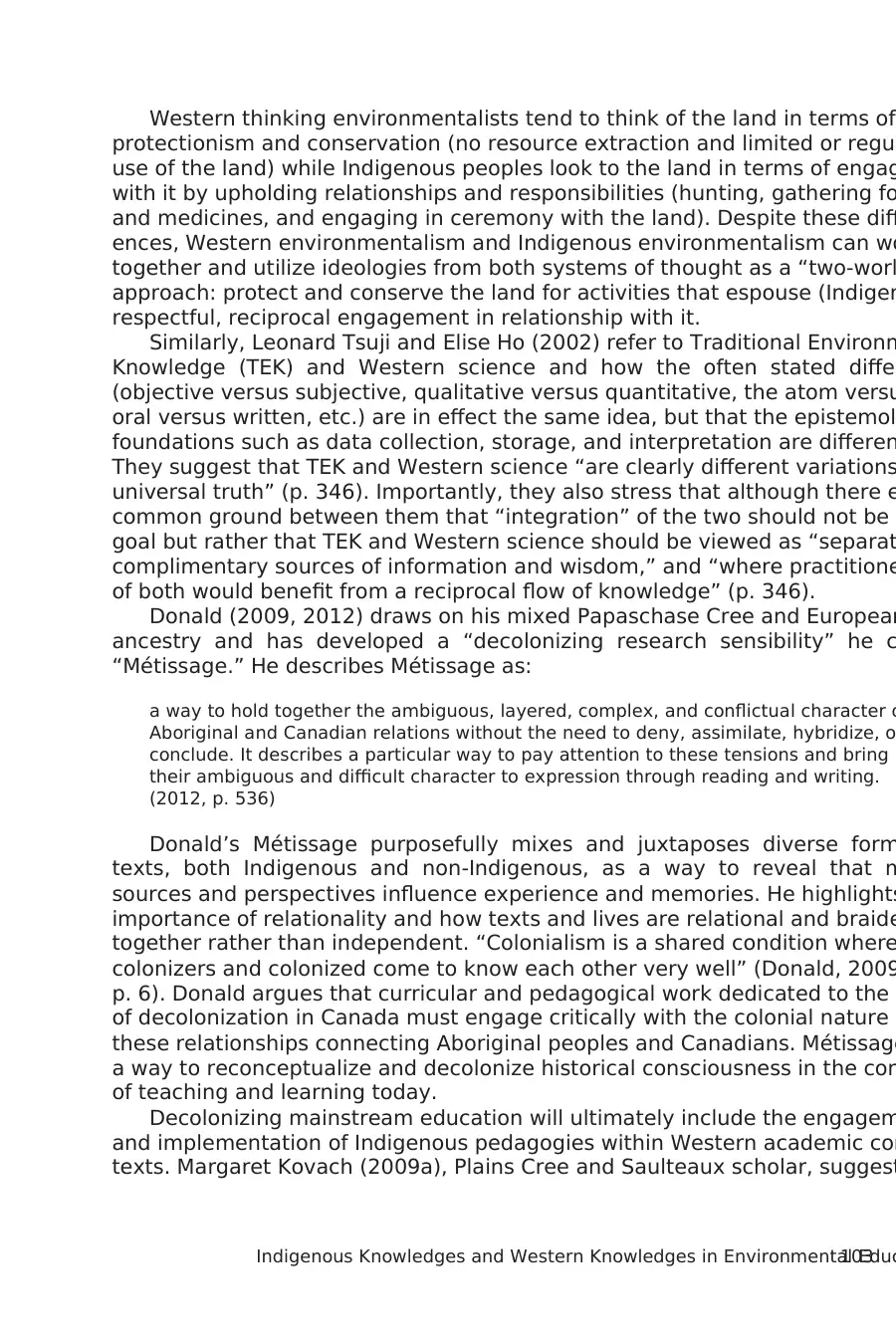
103Indigenous Knowledges and Western Knowledges in Environmental Educ
Western thinking environmentalists tend to think of the land in terms of
protectionism and conservation (no resource extraction and limited or regul
use of the land) while Indigenous peoples look to the land in terms of engag
with it by upholding relationships and responsibilities (hunting, gathering fo
and medicines, and engaging in ceremony with the land). Despite these diff
ences, Western environmentalism and Indigenous environmentalism can wo
together and utilize ideologies from both systems of thought as a “two-worl
approach: protect and conserve the land for activities that espouse (Indigen
respectful, reciprocal engagement in relationship with it.
Similarly, Leonard Tsuji and Elise Ho (2002) refer to Traditional Environm
Knowledge (TEK) and Western science and how the often stated differ
(objective versus subjective, qualitative versus quantitative, the atom versu
oral versus written, etc.) are in effect the same idea, but that the epistemol
foundations such as data collection, storage, and interpretation are differen
They suggest that TEK and Western science “are clearly different variations
universal truth” (p. 346). Importantly, they also stress that although there e
common ground between them that “integration” of the two should not be a
goal but rather that TEK and Western science should be viewed as “separat
complimentary sources of information and wisdom,” and “where practitione
of both would benefit from a reciprocal flow of knowledge” (p. 346).
Donald (2009, 2012) draws on his mixed Papaschase Cree and European
ancestry and has developed a “decolonizing research sensibility” he c
“Métissage.” He describes Métissage as:
a way to hold together the ambiguous, layered, complex, and conflictual character o
Aboriginal and Canadian relations without the need to deny, assimilate, hybridize, o
conclude. It describes a particular way to pay attention to these tensions and bring
their ambiguous and difficult character to expression through reading and writing.
(2012, p. 536)
Donald’s Métissage purposefully mixes and juxtaposes diverse form
texts, both Indigenous and non-Indigenous, as a way to reveal that m
sources and perspectives influence experience and memories. He highlights
importance of relationality and how texts and lives are relational and braide
together rather than independent. “Colonialism is a shared condition where
colonizers and colonized come to know each other very well” (Donald, 2009
p. 6). Donald argues that curricular and pedagogical work dedicated to the g
of decolonization in Canada must engage critically with the colonial nature o
these relationships connecting Aboriginal peoples and Canadians. Métissage
a way to reconceptualize and decolonize historical consciousness in the con
of teaching and learning today.
Decolonizing mainstream education will ultimately include the engagem
and implementation of Indigenous pedagogies within Western academic con
texts. Margaret Kovach (2009a), Plains Cree and Saulteaux scholar, suggest
Western thinking environmentalists tend to think of the land in terms of
protectionism and conservation (no resource extraction and limited or regul
use of the land) while Indigenous peoples look to the land in terms of engag
with it by upholding relationships and responsibilities (hunting, gathering fo
and medicines, and engaging in ceremony with the land). Despite these diff
ences, Western environmentalism and Indigenous environmentalism can wo
together and utilize ideologies from both systems of thought as a “two-worl
approach: protect and conserve the land for activities that espouse (Indigen
respectful, reciprocal engagement in relationship with it.
Similarly, Leonard Tsuji and Elise Ho (2002) refer to Traditional Environm
Knowledge (TEK) and Western science and how the often stated differ
(objective versus subjective, qualitative versus quantitative, the atom versu
oral versus written, etc.) are in effect the same idea, but that the epistemol
foundations such as data collection, storage, and interpretation are differen
They suggest that TEK and Western science “are clearly different variations
universal truth” (p. 346). Importantly, they also stress that although there e
common ground between them that “integration” of the two should not be a
goal but rather that TEK and Western science should be viewed as “separat
complimentary sources of information and wisdom,” and “where practitione
of both would benefit from a reciprocal flow of knowledge” (p. 346).
Donald (2009, 2012) draws on his mixed Papaschase Cree and European
ancestry and has developed a “decolonizing research sensibility” he c
“Métissage.” He describes Métissage as:
a way to hold together the ambiguous, layered, complex, and conflictual character o
Aboriginal and Canadian relations without the need to deny, assimilate, hybridize, o
conclude. It describes a particular way to pay attention to these tensions and bring
their ambiguous and difficult character to expression through reading and writing.
(2012, p. 536)
Donald’s Métissage purposefully mixes and juxtaposes diverse form
texts, both Indigenous and non-Indigenous, as a way to reveal that m
sources and perspectives influence experience and memories. He highlights
importance of relationality and how texts and lives are relational and braide
together rather than independent. “Colonialism is a shared condition where
colonizers and colonized come to know each other very well” (Donald, 2009
p. 6). Donald argues that curricular and pedagogical work dedicated to the g
of decolonization in Canada must engage critically with the colonial nature o
these relationships connecting Aboriginal peoples and Canadians. Métissage
a way to reconceptualize and decolonize historical consciousness in the con
of teaching and learning today.
Decolonizing mainstream education will ultimately include the engagem
and implementation of Indigenous pedagogies within Western academic con
texts. Margaret Kovach (2009a), Plains Cree and Saulteaux scholar, suggest
Secure Best Marks with AI Grader
Need help grading? Try our AI Grader for instant feedback on your assignments.
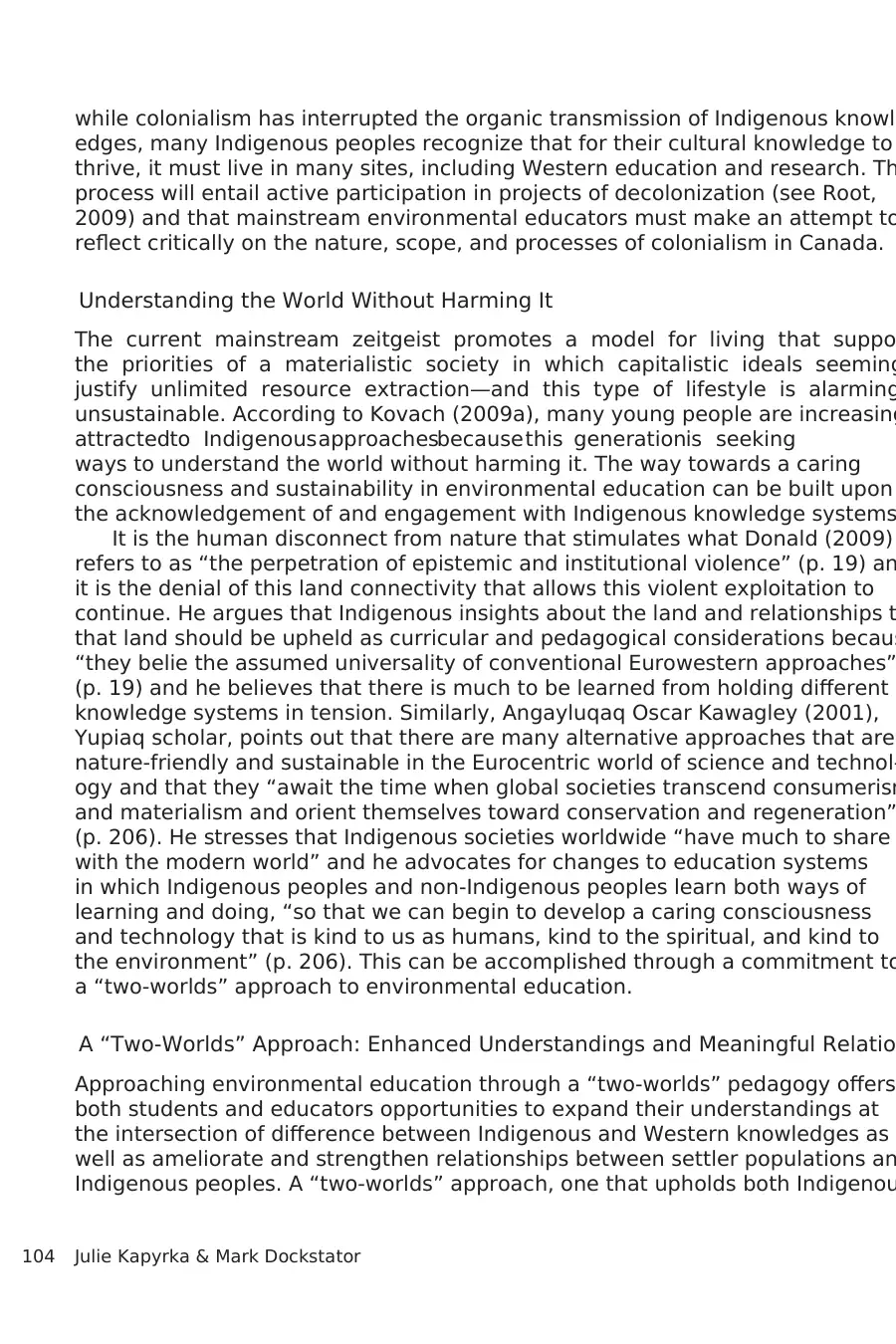
104 Julie Kapyrka & Mark Dockstator
while colonialism has interrupted the organic transmission of Indigenous knowl-
edges, many Indigenous peoples recognize that for their cultural knowledge to
thrive, it must live in many sites, including Western education and research. Th
process will entail active participation in projects of decolonization (see Root,
2009) and that mainstream environmental educators must make an attempt to
reflect critically on the nature, scope, and processes of colonialism in Canada.
Understanding the World Without Harming It
The current mainstream zeitgeist promotes a model for living that suppo
the priorities of a materialistic society in which capitalistic ideals seeming
justify unlimited resource extraction—and this type of lifestyle is alarming
unsustainable. According to Kovach (2009a), many young people are increasing
attractedto Indigenous approachesbecause this generationis seeking
ways to understand the world without harming it. The way towards a caring
consciousness and sustainability in environmental education can be built upon
the acknowledgement of and engagement with Indigenous knowledge systems
It is the human disconnect from nature that stimulates what Donald (2009)
refers to as “the perpetration of epistemic and institutional violence” (p. 19) an
it is the denial of this land connectivity that allows this violent exploitation to
continue. He argues that Indigenous insights about the land and relationships t
that land should be upheld as curricular and pedagogical considerations becaus
“they belie the assumed universality of conventional Eurowestern approaches”
(p. 19) and he believes that there is much to be learned from holding different
knowledge systems in tension. Similarly, Angayluqaq Oscar Kawagley (2001),
Yupiaq scholar, points out that there are many alternative approaches that are
nature-friendly and sustainable in the Eurocentric world of science and technol-
ogy and that they “await the time when global societies transcend consumerism
and materialism and orient themselves toward conservation and regeneration”
(p. 206). He stresses that Indigenous societies worldwide “have much to share
with the modern world” and he advocates for changes to education systems
in which Indigenous peoples and non-Indigenous peoples learn both ways of
learning and doing, “so that we can begin to develop a caring consciousness
and technology that is kind to us as humans, kind to the spiritual, and kind to
the environment” (p. 206). This can be accomplished through a commitment to
a “two-worlds” approach to environmental education.
A “Two-Worlds” Approach: Enhanced Understandings and Meaningful Relatio
Approaching environmental education through a “two-worlds” pedagogy offers
both students and educators opportunities to expand their understandings at
the intersection of difference between Indigenous and Western knowledges as
well as ameliorate and strengthen relationships between settler populations an
Indigenous peoples. A “two-worlds” approach, one that upholds both Indigenou
while colonialism has interrupted the organic transmission of Indigenous knowl-
edges, many Indigenous peoples recognize that for their cultural knowledge to
thrive, it must live in many sites, including Western education and research. Th
process will entail active participation in projects of decolonization (see Root,
2009) and that mainstream environmental educators must make an attempt to
reflect critically on the nature, scope, and processes of colonialism in Canada.
Understanding the World Without Harming It
The current mainstream zeitgeist promotes a model for living that suppo
the priorities of a materialistic society in which capitalistic ideals seeming
justify unlimited resource extraction—and this type of lifestyle is alarming
unsustainable. According to Kovach (2009a), many young people are increasing
attractedto Indigenous approachesbecause this generationis seeking
ways to understand the world without harming it. The way towards a caring
consciousness and sustainability in environmental education can be built upon
the acknowledgement of and engagement with Indigenous knowledge systems
It is the human disconnect from nature that stimulates what Donald (2009)
refers to as “the perpetration of epistemic and institutional violence” (p. 19) an
it is the denial of this land connectivity that allows this violent exploitation to
continue. He argues that Indigenous insights about the land and relationships t
that land should be upheld as curricular and pedagogical considerations becaus
“they belie the assumed universality of conventional Eurowestern approaches”
(p. 19) and he believes that there is much to be learned from holding different
knowledge systems in tension. Similarly, Angayluqaq Oscar Kawagley (2001),
Yupiaq scholar, points out that there are many alternative approaches that are
nature-friendly and sustainable in the Eurocentric world of science and technol-
ogy and that they “await the time when global societies transcend consumerism
and materialism and orient themselves toward conservation and regeneration”
(p. 206). He stresses that Indigenous societies worldwide “have much to share
with the modern world” and he advocates for changes to education systems
in which Indigenous peoples and non-Indigenous peoples learn both ways of
learning and doing, “so that we can begin to develop a caring consciousness
and technology that is kind to us as humans, kind to the spiritual, and kind to
the environment” (p. 206). This can be accomplished through a commitment to
a “two-worlds” approach to environmental education.
A “Two-Worlds” Approach: Enhanced Understandings and Meaningful Relatio
Approaching environmental education through a “two-worlds” pedagogy offers
both students and educators opportunities to expand their understandings at
the intersection of difference between Indigenous and Western knowledges as
well as ameliorate and strengthen relationships between settler populations an
Indigenous peoples. A “two-worlds” approach, one that upholds both Indigenou

105Indigenous Knowledges and Western Knowledges in Environmental Educ
and Western worldviews, has been accomplished in various academic locale
across Canada and the United States. Lawrence Gross (2005, 2010), Minnes
Chippewa, engages with what he calls a “blended” teaching method that dr
from American Indian pedagogical approaches as well as methods traditiona
the academy. Marilyn Iwama and Cheryl Bartlett, working closely with Mi’km
Elder Albert Marshall, have recently offered an “integrative science” u
“Two-Eyed Seeing” approach that draws together the strengths of We
and Mi’kmaq knowledges (Bartlett et al., in press; Iwama et al., 2009). Thes
researchers explain that by engaging the overlapping perspective of each “
there is a guiding principle of binocularity to their integrative science
experiences a wider, deeper, and more generative “field of view” than migh
either of these perspectives in isolation. Similar to Donald’s “Métissage,” “T
Eyed Seeing” emphasizes a weaving back and forth between knowled
which each strand is necessary to the process.
Jonathan Anuik and Carmen Gillies (2012) apply Indigenous teachings to
assist in the collaboration of the heart and brain because they argue
mainstream education systems, there is a disconnect between the two and
true or holistic learning cannot occur. They share the philosophy that “learn
must enable the heart, brain, body, and spirit to collaborate to evoke an out
ing of critical thought and personal transformation” (p. 75). Kovach has also
done extensive work in bringing Indigenous methodologies into the classroo
and upholds the importance of creating space in the academy for Indigenou
ways of knowing (2005, 2009a, 2009b, 2010). Kovach’s work offers concept
possibilities for research that rests upon tribal perspectives, bridging Plains
knowledges and their methods in a manner translatable to Western researc
Laara Fitznor (2005), Cree mixed heritage, incorporates traditional Aborigin
learning methods of sharing, learning and talking circles for healing, teachin
and decision-making in her courses.
One of the most notable examples of a “two-worlds” approach inc
the Indigenous Environmental Studies Program (IES) at Trent University
is a collaborative effort between the Department of Indigenous Studie
the Environmental and Resource Science/Studies Program and is designed t
give students the necessary skills and knowledge to work in the growing fie
of Indigenous environmental issues. The program uses Indigenous knowledg
systems, Western science, and information from the social and environmen
sciences to explore local, regional, national, and international environmenta
issues impacting Indigenous peoples (Trent University, 2011). As of the 200
2010 calendar year, the IES program has offered a B.A. or a B.Sc. as well as
Diploma in Indigenous Environmental Studies. Trent is the first univers
North America and worldwide to grant university-level degrees in Indigenou
EnvironmentalStudies.Leanne Simpson (2002), Anishinaabeand former
Director of IES at Trent University, highlights the importance of the following
concepts in terms of respectful and inclusive curricula: Indigenous knowledg
and Western worldviews, has been accomplished in various academic locale
across Canada and the United States. Lawrence Gross (2005, 2010), Minnes
Chippewa, engages with what he calls a “blended” teaching method that dr
from American Indian pedagogical approaches as well as methods traditiona
the academy. Marilyn Iwama and Cheryl Bartlett, working closely with Mi’km
Elder Albert Marshall, have recently offered an “integrative science” u
“Two-Eyed Seeing” approach that draws together the strengths of We
and Mi’kmaq knowledges (Bartlett et al., in press; Iwama et al., 2009). Thes
researchers explain that by engaging the overlapping perspective of each “
there is a guiding principle of binocularity to their integrative science
experiences a wider, deeper, and more generative “field of view” than migh
either of these perspectives in isolation. Similar to Donald’s “Métissage,” “T
Eyed Seeing” emphasizes a weaving back and forth between knowled
which each strand is necessary to the process.
Jonathan Anuik and Carmen Gillies (2012) apply Indigenous teachings to
assist in the collaboration of the heart and brain because they argue
mainstream education systems, there is a disconnect between the two and
true or holistic learning cannot occur. They share the philosophy that “learn
must enable the heart, brain, body, and spirit to collaborate to evoke an out
ing of critical thought and personal transformation” (p. 75). Kovach has also
done extensive work in bringing Indigenous methodologies into the classroo
and upholds the importance of creating space in the academy for Indigenou
ways of knowing (2005, 2009a, 2009b, 2010). Kovach’s work offers concept
possibilities for research that rests upon tribal perspectives, bridging Plains
knowledges and their methods in a manner translatable to Western researc
Laara Fitznor (2005), Cree mixed heritage, incorporates traditional Aborigin
learning methods of sharing, learning and talking circles for healing, teachin
and decision-making in her courses.
One of the most notable examples of a “two-worlds” approach inc
the Indigenous Environmental Studies Program (IES) at Trent University
is a collaborative effort between the Department of Indigenous Studie
the Environmental and Resource Science/Studies Program and is designed t
give students the necessary skills and knowledge to work in the growing fie
of Indigenous environmental issues. The program uses Indigenous knowledg
systems, Western science, and information from the social and environmen
sciences to explore local, regional, national, and international environmenta
issues impacting Indigenous peoples (Trent University, 2011). As of the 200
2010 calendar year, the IES program has offered a B.A. or a B.Sc. as well as
Diploma in Indigenous Environmental Studies. Trent is the first univers
North America and worldwide to grant university-level degrees in Indigenou
EnvironmentalStudies.Leanne Simpson (2002), Anishinaabeand former
Director of IES at Trent University, highlights the importance of the following
concepts in terms of respectful and inclusive curricula: Indigenous knowledg
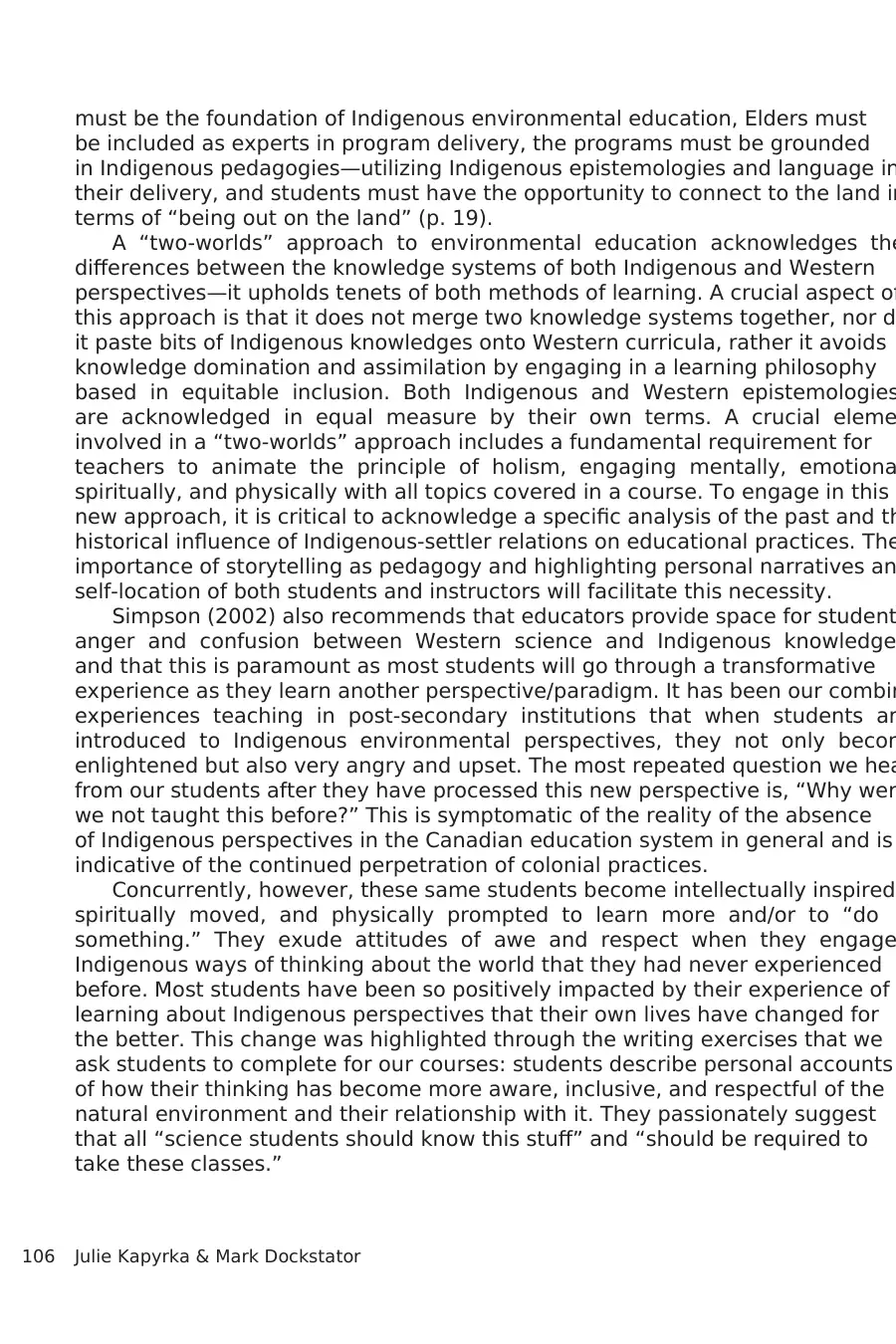
106 Julie Kapyrka & Mark Dockstator
must be the foundation of Indigenous environmental education, Elders must
be included as experts in program delivery, the programs must be grounded
in Indigenous pedagogies—utilizing Indigenous epistemologies and language in
their delivery, and students must have the opportunity to connect to the land in
terms of “being out on the land” (p. 19).
A “two-worlds” approach to environmental education acknowledges the
differences between the knowledge systems of both Indigenous and Western
perspectives—it upholds tenets of both methods of learning. A crucial aspect of
this approach is that it does not merge two knowledge systems together, nor d
it paste bits of Indigenous knowledges onto Western curricula, rather it avoids
knowledge domination and assimilation by engaging in a learning philosophy
based in equitable inclusion. Both Indigenous and Western epistemologies
are acknowledged in equal measure by their own terms. A crucial eleme
involved in a “two-worlds” approach includes a fundamental requirement for
teachers to animate the principle of holism, engaging mentally, emotiona
spiritually, and physically with all topics covered in a course. To engage in this
new approach, it is critical to acknowledge a specific analysis of the past and th
historical influence of Indigenous-settler relations on educational practices. The
importance of storytelling as pedagogy and highlighting personal narratives an
self-location of both students and instructors will facilitate this necessity.
Simpson (2002) also recommends that educators provide space for student
anger and confusion between Western science and Indigenous knowledge
and that this is paramount as most students will go through a transformative
experience as they learn another perspective/paradigm. It has been our combin
experiences teaching in post-secondary institutions that when students ar
introduced to Indigenous environmental perspectives, they not only becom
enlightened but also very angry and upset. The most repeated question we hea
from our students after they have processed this new perspective is, “Why wer
we not taught this before?” This is symptomatic of the reality of the absence
of Indigenous perspectives in the Canadian education system in general and is
indicative of the continued perpetration of colonial practices.
Concurrently, however, these same students become intellectually inspired,
spiritually moved, and physically prompted to learn more and/or to “do
something.” They exude attitudes of awe and respect when they engage
Indigenous ways of thinking about the world that they had never experienced
before. Most students have been so positively impacted by their experience of
learning about Indigenous perspectives that their own lives have changed for
the better. This change was highlighted through the writing exercises that we
ask students to complete for our courses: students describe personal accounts
of how their thinking has become more aware, inclusive, and respectful of the
natural environment and their relationship with it. They passionately suggest
that all “science students should know this stuff” and “should be required to
take these classes.”
must be the foundation of Indigenous environmental education, Elders must
be included as experts in program delivery, the programs must be grounded
in Indigenous pedagogies—utilizing Indigenous epistemologies and language in
their delivery, and students must have the opportunity to connect to the land in
terms of “being out on the land” (p. 19).
A “two-worlds” approach to environmental education acknowledges the
differences between the knowledge systems of both Indigenous and Western
perspectives—it upholds tenets of both methods of learning. A crucial aspect of
this approach is that it does not merge two knowledge systems together, nor d
it paste bits of Indigenous knowledges onto Western curricula, rather it avoids
knowledge domination and assimilation by engaging in a learning philosophy
based in equitable inclusion. Both Indigenous and Western epistemologies
are acknowledged in equal measure by their own terms. A crucial eleme
involved in a “two-worlds” approach includes a fundamental requirement for
teachers to animate the principle of holism, engaging mentally, emotiona
spiritually, and physically with all topics covered in a course. To engage in this
new approach, it is critical to acknowledge a specific analysis of the past and th
historical influence of Indigenous-settler relations on educational practices. The
importance of storytelling as pedagogy and highlighting personal narratives an
self-location of both students and instructors will facilitate this necessity.
Simpson (2002) also recommends that educators provide space for student
anger and confusion between Western science and Indigenous knowledge
and that this is paramount as most students will go through a transformative
experience as they learn another perspective/paradigm. It has been our combin
experiences teaching in post-secondary institutions that when students ar
introduced to Indigenous environmental perspectives, they not only becom
enlightened but also very angry and upset. The most repeated question we hea
from our students after they have processed this new perspective is, “Why wer
we not taught this before?” This is symptomatic of the reality of the absence
of Indigenous perspectives in the Canadian education system in general and is
indicative of the continued perpetration of colonial practices.
Concurrently, however, these same students become intellectually inspired,
spiritually moved, and physically prompted to learn more and/or to “do
something.” They exude attitudes of awe and respect when they engage
Indigenous ways of thinking about the world that they had never experienced
before. Most students have been so positively impacted by their experience of
learning about Indigenous perspectives that their own lives have changed for
the better. This change was highlighted through the writing exercises that we
ask students to complete for our courses: students describe personal accounts
of how their thinking has become more aware, inclusive, and respectful of the
natural environment and their relationship with it. They passionately suggest
that all “science students should know this stuff” and “should be required to
take these classes.”
Paraphrase This Document
Need a fresh take? Get an instant paraphrase of this document with our AI Paraphraser
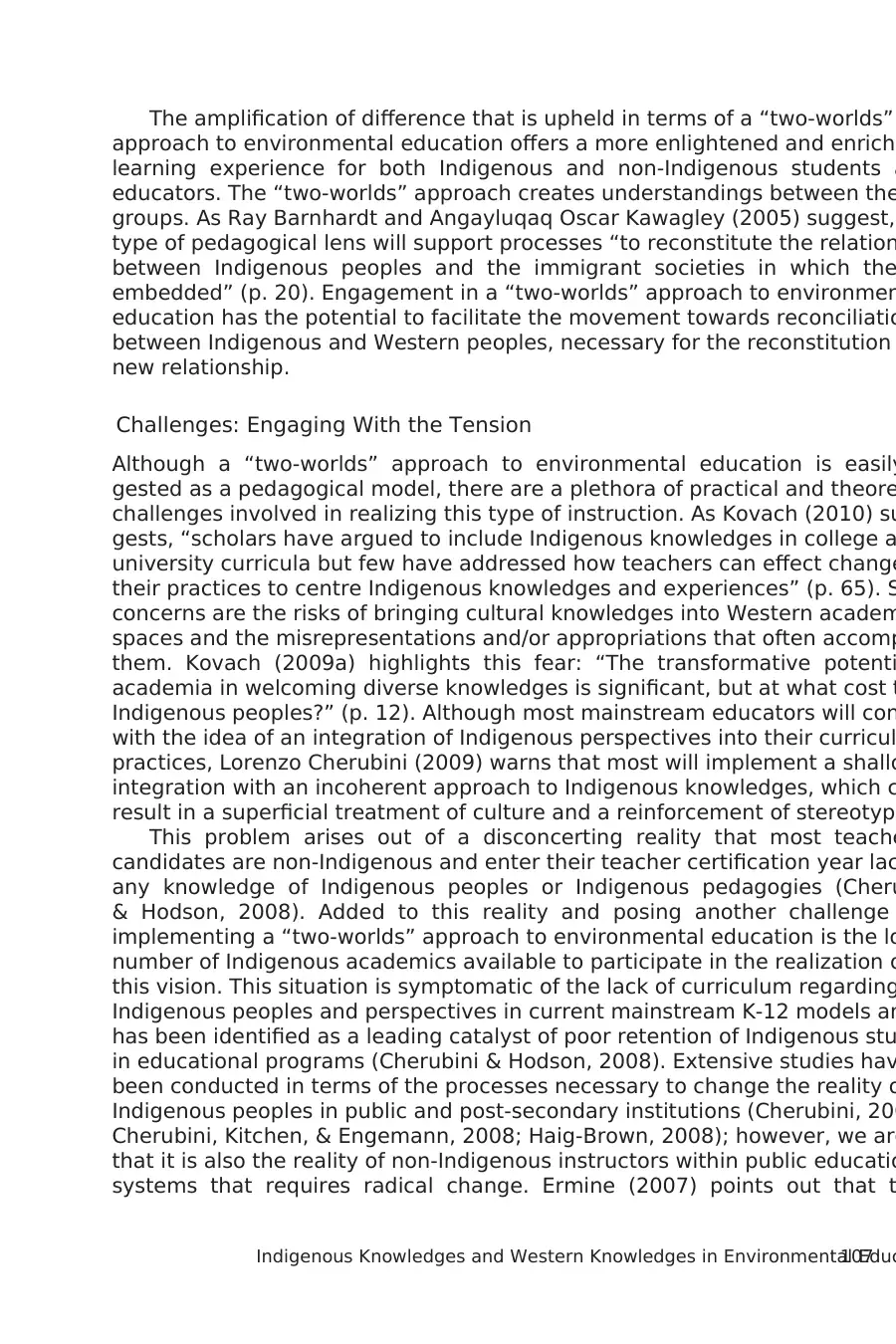
107Indigenous Knowledges and Western Knowledges in Environmental Educ
The amplification of difference that is upheld in terms of a “two-worlds”
approach to environmental education offers a more enlightened and enriche
learning experience for both Indigenous and non-Indigenous students a
educators. The “two-worlds” approach creates understandings between the
groups. As Ray Barnhardt and Angayluqaq Oscar Kawagley (2005) suggest,
type of pedagogical lens will support processes “to reconstitute the relation
between Indigenous peoples and the immigrant societies in which the
embedded” (p. 20). Engagement in a “two-worlds” approach to environmen
education has the potential to facilitate the movement towards reconciliatio
between Indigenous and Western peoples, necessary for the reconstitution
new relationship.
Challenges: Engaging With the Tension
Although a “two-worlds” approach to environmental education is easily
gested as a pedagogical model, there are a plethora of practical and theore
challenges involved in realizing this type of instruction. As Kovach (2010) su
gests, “scholars have argued to include Indigenous knowledges in college a
university curricula but few have addressed how teachers can effect change
their practices to centre Indigenous knowledges and experiences” (p. 65). S
concerns are the risks of bringing cultural knowledges into Western academ
spaces and the misrepresentations and/or appropriations that often accomp
them. Kovach (2009a) highlights this fear: “The transformative potenti
academia in welcoming diverse knowledges is significant, but at what cost t
Indigenous peoples?” (p. 12). Although most mainstream educators will con
with the idea of an integration of Indigenous perspectives into their curricul
practices, Lorenzo Cherubini (2009) warns that most will implement a shallo
integration with an incoherent approach to Indigenous knowledges, which c
result in a superficial treatment of culture and a reinforcement of stereotype
This problem arises out of a disconcerting reality that most teache
candidates are non-Indigenous and enter their teacher certification year lac
any knowledge of Indigenous peoples or Indigenous pedagogies (Cheru
& Hodson, 2008). Added to this reality and posing another challenge
implementing a “two-worlds” approach to environmental education is the lo
number of Indigenous academics available to participate in the realization o
this vision. This situation is symptomatic of the lack of curriculum regarding
Indigenous peoples and perspectives in current mainstream K-12 models an
has been identified as a leading catalyst of poor retention of Indigenous stu
in educational programs (Cherubini & Hodson, 2008). Extensive studies hav
been conducted in terms of the processes necessary to change the reality o
Indigenous peoples in public and post-secondary institutions (Cherubini, 200
Cherubini, Kitchen, & Engemann, 2008; Haig-Brown, 2008); however, we arg
that it is also the reality of non-Indigenous instructors within public educatio
systems that requires radical change. Ermine (2007) points out that t
The amplification of difference that is upheld in terms of a “two-worlds”
approach to environmental education offers a more enlightened and enriche
learning experience for both Indigenous and non-Indigenous students a
educators. The “two-worlds” approach creates understandings between the
groups. As Ray Barnhardt and Angayluqaq Oscar Kawagley (2005) suggest,
type of pedagogical lens will support processes “to reconstitute the relation
between Indigenous peoples and the immigrant societies in which the
embedded” (p. 20). Engagement in a “two-worlds” approach to environmen
education has the potential to facilitate the movement towards reconciliatio
between Indigenous and Western peoples, necessary for the reconstitution
new relationship.
Challenges: Engaging With the Tension
Although a “two-worlds” approach to environmental education is easily
gested as a pedagogical model, there are a plethora of practical and theore
challenges involved in realizing this type of instruction. As Kovach (2010) su
gests, “scholars have argued to include Indigenous knowledges in college a
university curricula but few have addressed how teachers can effect change
their practices to centre Indigenous knowledges and experiences” (p. 65). S
concerns are the risks of bringing cultural knowledges into Western academ
spaces and the misrepresentations and/or appropriations that often accomp
them. Kovach (2009a) highlights this fear: “The transformative potenti
academia in welcoming diverse knowledges is significant, but at what cost t
Indigenous peoples?” (p. 12). Although most mainstream educators will con
with the idea of an integration of Indigenous perspectives into their curricul
practices, Lorenzo Cherubini (2009) warns that most will implement a shallo
integration with an incoherent approach to Indigenous knowledges, which c
result in a superficial treatment of culture and a reinforcement of stereotype
This problem arises out of a disconcerting reality that most teache
candidates are non-Indigenous and enter their teacher certification year lac
any knowledge of Indigenous peoples or Indigenous pedagogies (Cheru
& Hodson, 2008). Added to this reality and posing another challenge
implementing a “two-worlds” approach to environmental education is the lo
number of Indigenous academics available to participate in the realization o
this vision. This situation is symptomatic of the lack of curriculum regarding
Indigenous peoples and perspectives in current mainstream K-12 models an
has been identified as a leading catalyst of poor retention of Indigenous stu
in educational programs (Cherubini & Hodson, 2008). Extensive studies hav
been conducted in terms of the processes necessary to change the reality o
Indigenous peoples in public and post-secondary institutions (Cherubini, 200
Cherubini, Kitchen, & Engemann, 2008; Haig-Brown, 2008); however, we arg
that it is also the reality of non-Indigenous instructors within public educatio
systems that requires radical change. Ermine (2007) points out that t
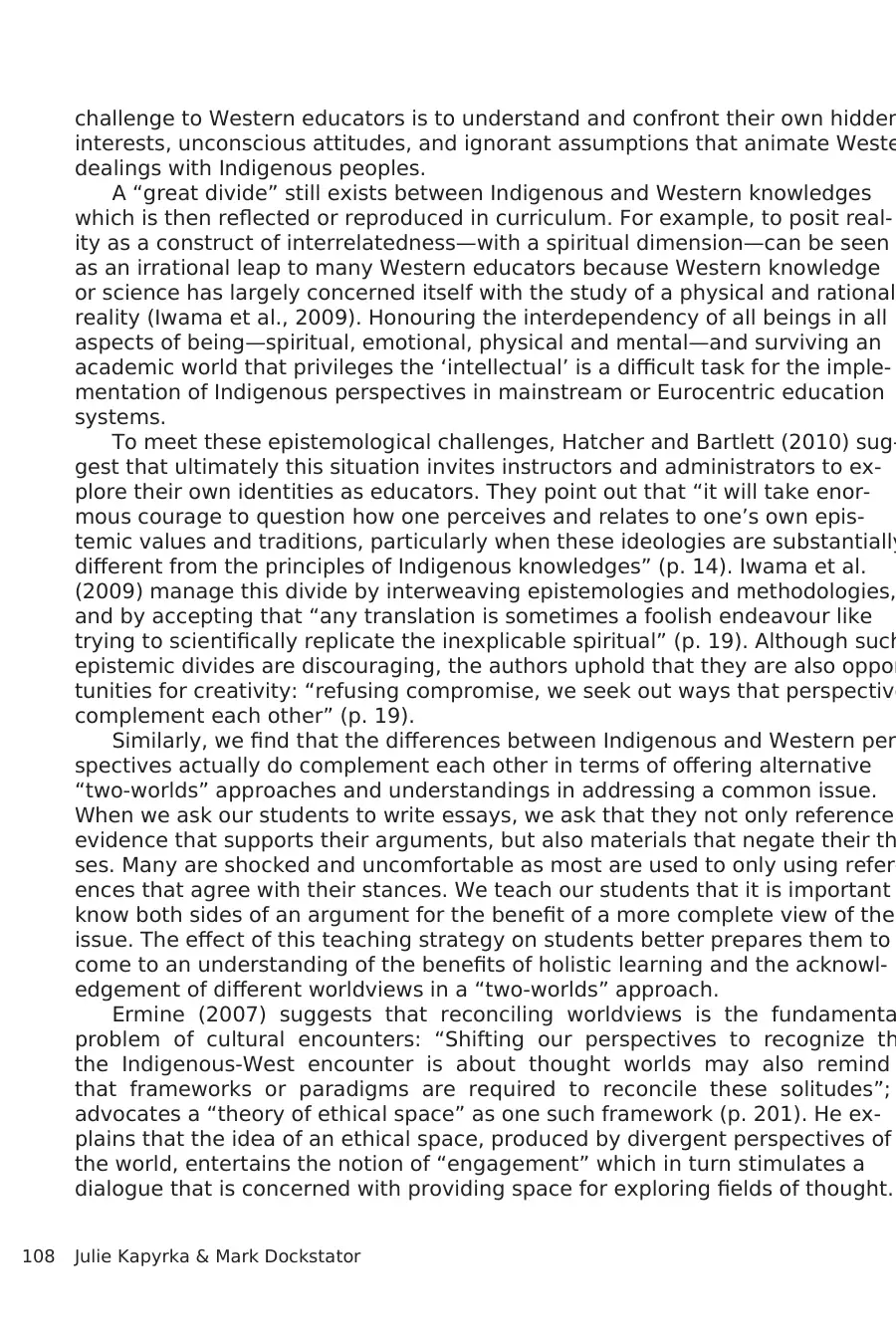
108 Julie Kapyrka & Mark Dockstator
challenge to Western educators is to understand and confront their own hidden
interests, unconscious attitudes, and ignorant assumptions that animate Weste
dealings with Indigenous peoples.
A “great divide” still exists between Indigenous and Western knowledges
which is then reflected or reproduced in curriculum. For example, to posit real-
ity as a construct of interrelatedness—with a spiritual dimension—can be seen
as an irrational leap to many Western educators because Western knowledge
or science has largely concerned itself with the study of a physical and rational
reality (Iwama et al., 2009). Honouring the interdependency of all beings in all
aspects of being—spiritual, emotional, physical and mental—and surviving an
academic world that privileges the ‘intellectual’ is a difficult task for the imple-
mentation of Indigenous perspectives in mainstream or Eurocentric education
systems.
To meet these epistemological challenges, Hatcher and Bartlett (2010) sug-
gest that ultimately this situation invites instructors and administrators to ex-
plore their own identities as educators. They point out that “it will take enor-
mous courage to question how one perceives and relates to one’s own epis-
temic values and traditions, particularly when these ideologies are substantially
different from the principles of Indigenous knowledges” (p. 14). Iwama et al.
(2009) manage this divide by interweaving epistemologies and methodologies,
and by accepting that “any translation is sometimes a foolish endeavour like
trying to scientifically replicate the inexplicable spiritual” (p. 19). Although such
epistemic divides are discouraging, the authors uphold that they are also oppor
tunities for creativity: “refusing compromise, we seek out ways that perspective
complement each other” (p. 19).
Similarly, we find that the differences between Indigenous and Western per
spectives actually do complement each other in terms of offering alternative
“two-worlds” approaches and understandings in addressing a common issue.
When we ask our students to write essays, we ask that they not only reference
evidence that supports their arguments, but also materials that negate their th
ses. Many are shocked and uncomfortable as most are used to only using refer-
ences that agree with their stances. We teach our students that it is important
know both sides of an argument for the benefit of a more complete view of the
issue. The effect of this teaching strategy on students better prepares them to
come to an understanding of the benefits of holistic learning and the acknowl-
edgement of different worldviews in a “two-worlds” approach.
Ermine (2007) suggests that reconciling worldviews is the fundamenta
problem of cultural encounters: “Shifting our perspectives to recognize th
the Indigenous-West encounter is about thought worlds may also remind
that frameworks or paradigms are required to reconcile these solitudes”;
advocates a “theory of ethical space” as one such framework (p. 201). He ex-
plains that the idea of an ethical space, produced by divergent perspectives of
the world, entertains the notion of “engagement” which in turn stimulates a
dialogue that is concerned with providing space for exploring fields of thought.
challenge to Western educators is to understand and confront their own hidden
interests, unconscious attitudes, and ignorant assumptions that animate Weste
dealings with Indigenous peoples.
A “great divide” still exists between Indigenous and Western knowledges
which is then reflected or reproduced in curriculum. For example, to posit real-
ity as a construct of interrelatedness—with a spiritual dimension—can be seen
as an irrational leap to many Western educators because Western knowledge
or science has largely concerned itself with the study of a physical and rational
reality (Iwama et al., 2009). Honouring the interdependency of all beings in all
aspects of being—spiritual, emotional, physical and mental—and surviving an
academic world that privileges the ‘intellectual’ is a difficult task for the imple-
mentation of Indigenous perspectives in mainstream or Eurocentric education
systems.
To meet these epistemological challenges, Hatcher and Bartlett (2010) sug-
gest that ultimately this situation invites instructors and administrators to ex-
plore their own identities as educators. They point out that “it will take enor-
mous courage to question how one perceives and relates to one’s own epis-
temic values and traditions, particularly when these ideologies are substantially
different from the principles of Indigenous knowledges” (p. 14). Iwama et al.
(2009) manage this divide by interweaving epistemologies and methodologies,
and by accepting that “any translation is sometimes a foolish endeavour like
trying to scientifically replicate the inexplicable spiritual” (p. 19). Although such
epistemic divides are discouraging, the authors uphold that they are also oppor
tunities for creativity: “refusing compromise, we seek out ways that perspective
complement each other” (p. 19).
Similarly, we find that the differences between Indigenous and Western per
spectives actually do complement each other in terms of offering alternative
“two-worlds” approaches and understandings in addressing a common issue.
When we ask our students to write essays, we ask that they not only reference
evidence that supports their arguments, but also materials that negate their th
ses. Many are shocked and uncomfortable as most are used to only using refer-
ences that agree with their stances. We teach our students that it is important
know both sides of an argument for the benefit of a more complete view of the
issue. The effect of this teaching strategy on students better prepares them to
come to an understanding of the benefits of holistic learning and the acknowl-
edgement of different worldviews in a “two-worlds” approach.
Ermine (2007) suggests that reconciling worldviews is the fundamenta
problem of cultural encounters: “Shifting our perspectives to recognize th
the Indigenous-West encounter is about thought worlds may also remind
that frameworks or paradigms are required to reconcile these solitudes”;
advocates a “theory of ethical space” as one such framework (p. 201). He ex-
plains that the idea of an ethical space, produced by divergent perspectives of
the world, entertains the notion of “engagement” which in turn stimulates a
dialogue that is concerned with providing space for exploring fields of thought.
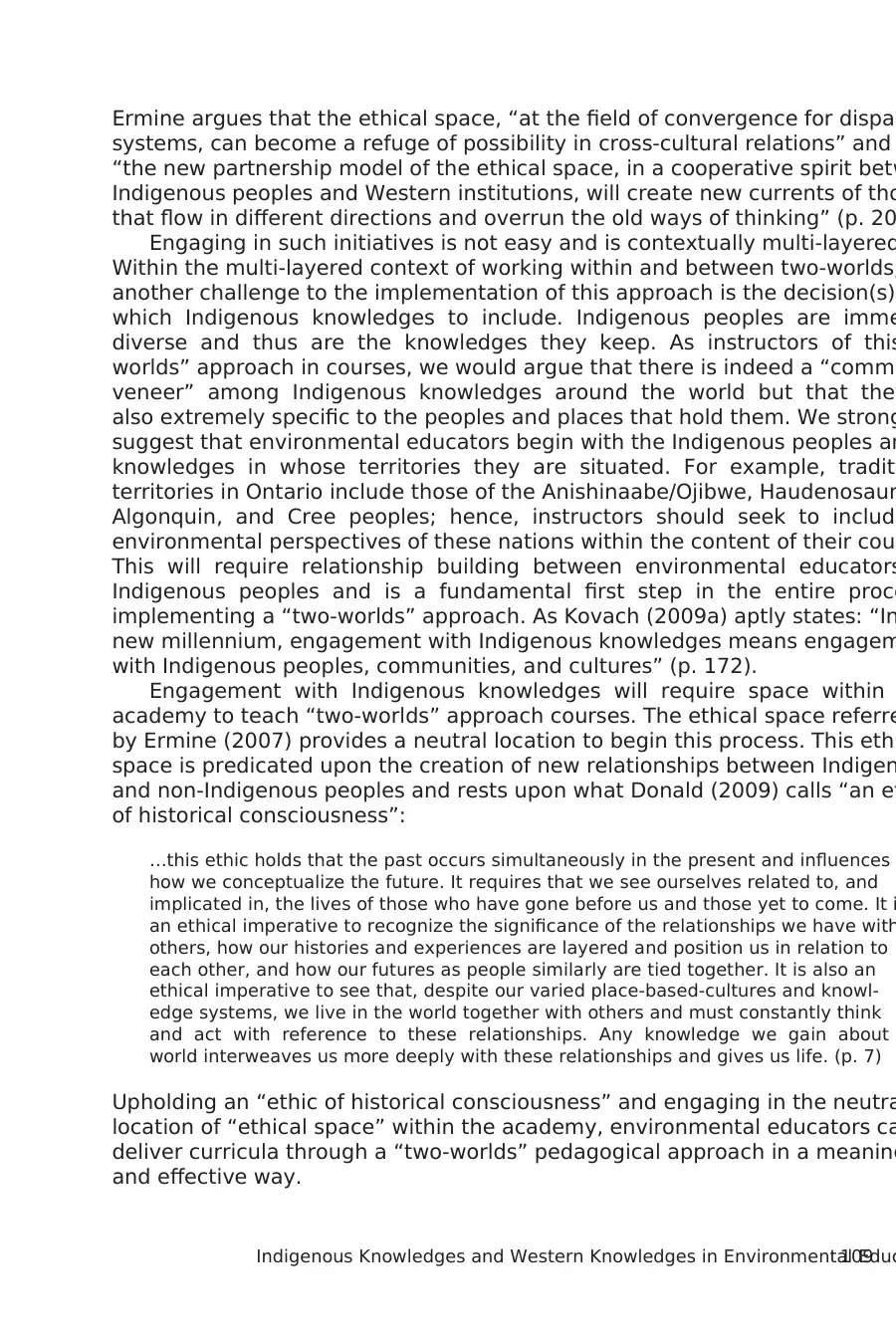
109Indigenous Knowledges and Western Knowledges in Environmental Educ
Ermine argues that the ethical space, “at the field of convergence for dispar
systems, can become a refuge of possibility in cross-cultural relations” and
“the new partnership model of the ethical space, in a cooperative spirit betw
Indigenous peoples and Western institutions, will create new currents of tho
that flow in different directions and overrun the old ways of thinking” (p. 20
Engaging in such initiatives is not easy and is contextually multi-layered
Within the multi-layered context of working within and between two-worlds,
another challenge to the implementation of this approach is the decision(s)
which Indigenous knowledges to include. Indigenous peoples are imme
diverse and thus are the knowledges they keep. As instructors of this
worlds” approach in courses, we would argue that there is indeed a “commo
veneer” among Indigenous knowledges around the world but that they
also extremely specific to the peoples and places that hold them. We strong
suggest that environmental educators begin with the Indigenous peoples an
knowledges in whose territories they are situated. For example, traditi
territories in Ontario include those of the Anishinaabe/Ojibwe, Haudenosaun
Algonquin, and Cree peoples; hence, instructors should seek to include
environmental perspectives of these nations within the content of their cour
This will require relationship building between environmental educators
Indigenous peoples and is a fundamental first step in the entire proce
implementing a “two-worlds” approach. As Kovach (2009a) aptly states: “In
new millennium, engagement with Indigenous knowledges means engagem
with Indigenous peoples, communities, and cultures” (p. 172).
Engagement with Indigenous knowledges will require space within
academy to teach “two-worlds” approach courses. The ethical space referre
by Ermine (2007) provides a neutral location to begin this process. This ethi
space is predicated upon the creation of new relationships between Indigen
and non-Indigenous peoples and rests upon what Donald (2009) calls “an et
of historical consciousness”:
…this ethic holds that the past occurs simultaneously in the present and influences
how we conceptualize the future. It requires that we see ourselves related to, and
implicated in, the lives of those who have gone before us and those yet to come. It i
an ethical imperative to recognize the significance of the relationships we have with
others, how our histories and experiences are layered and position us in relation to
each other, and how our futures as people similarly are tied together. It is also an
ethical imperative to see that, despite our varied place-based-cultures and knowl-
edge systems, we live in the world together with others and must constantly think
and act with reference to these relationships. Any knowledge we gain about
world interweaves us more deeply with these relationships and gives us life. (p. 7)
Upholding an “ethic of historical consciousness” and engaging in the neutra
location of “ethical space” within the academy, environmental educators ca
deliver curricula through a “two-worlds” pedagogical approach in a meaning
and effective way.
Ermine argues that the ethical space, “at the field of convergence for dispar
systems, can become a refuge of possibility in cross-cultural relations” and
“the new partnership model of the ethical space, in a cooperative spirit betw
Indigenous peoples and Western institutions, will create new currents of tho
that flow in different directions and overrun the old ways of thinking” (p. 20
Engaging in such initiatives is not easy and is contextually multi-layered
Within the multi-layered context of working within and between two-worlds,
another challenge to the implementation of this approach is the decision(s)
which Indigenous knowledges to include. Indigenous peoples are imme
diverse and thus are the knowledges they keep. As instructors of this
worlds” approach in courses, we would argue that there is indeed a “commo
veneer” among Indigenous knowledges around the world but that they
also extremely specific to the peoples and places that hold them. We strong
suggest that environmental educators begin with the Indigenous peoples an
knowledges in whose territories they are situated. For example, traditi
territories in Ontario include those of the Anishinaabe/Ojibwe, Haudenosaun
Algonquin, and Cree peoples; hence, instructors should seek to include
environmental perspectives of these nations within the content of their cour
This will require relationship building between environmental educators
Indigenous peoples and is a fundamental first step in the entire proce
implementing a “two-worlds” approach. As Kovach (2009a) aptly states: “In
new millennium, engagement with Indigenous knowledges means engagem
with Indigenous peoples, communities, and cultures” (p. 172).
Engagement with Indigenous knowledges will require space within
academy to teach “two-worlds” approach courses. The ethical space referre
by Ermine (2007) provides a neutral location to begin this process. This ethi
space is predicated upon the creation of new relationships between Indigen
and non-Indigenous peoples and rests upon what Donald (2009) calls “an et
of historical consciousness”:
…this ethic holds that the past occurs simultaneously in the present and influences
how we conceptualize the future. It requires that we see ourselves related to, and
implicated in, the lives of those who have gone before us and those yet to come. It i
an ethical imperative to recognize the significance of the relationships we have with
others, how our histories and experiences are layered and position us in relation to
each other, and how our futures as people similarly are tied together. It is also an
ethical imperative to see that, despite our varied place-based-cultures and knowl-
edge systems, we live in the world together with others and must constantly think
and act with reference to these relationships. Any knowledge we gain about
world interweaves us more deeply with these relationships and gives us life. (p. 7)
Upholding an “ethic of historical consciousness” and engaging in the neutra
location of “ethical space” within the academy, environmental educators ca
deliver curricula through a “two-worlds” pedagogical approach in a meaning
and effective way.
Secure Best Marks with AI Grader
Need help grading? Try our AI Grader for instant feedback on your assignments.
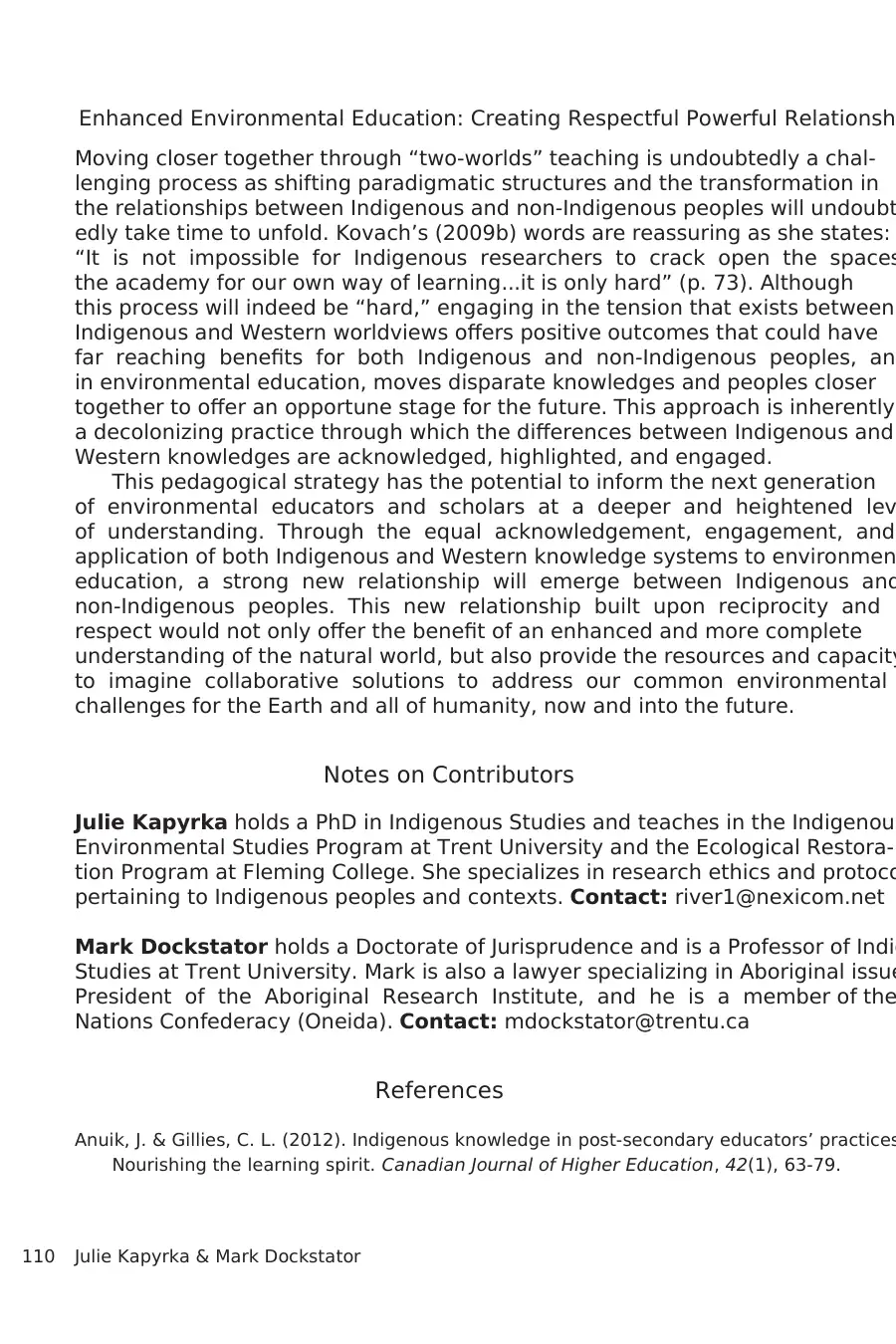
110 Julie Kapyrka & Mark Dockstator
Enhanced Environmental Education: Creating Respectful Powerful Relationshi
Moving closer together through “two-worlds” teaching is undoubtedly a chal-
lenging process as shifting paradigmatic structures and the transformation in
the relationships between Indigenous and non-Indigenous peoples will undoubt
edly take time to unfold. Kovach’s (2009b) words are reassuring as she states:
“It is not impossible for Indigenous researchers to crack open the spaces
the academy for our own way of learning...it is only hard” (p. 73). Although
this process will indeed be “hard,” engaging in the tension that exists between
Indigenous and Western worldviews offers positive outcomes that could have
far reaching benefits for both Indigenous and non-Indigenous peoples, and
in environmental education, moves disparate knowledges and peoples closer
together to offer an opportune stage for the future. This approach is inherently
a decolonizing practice through which the differences between Indigenous and
Western knowledges are acknowledged, highlighted, and engaged.
This pedagogical strategy has the potential to inform the next generation
of environmental educators and scholars at a deeper and heightened lev
of understanding. Through the equal acknowledgement, engagement, and
application of both Indigenous and Western knowledge systems to environmen
education, a strong new relationship will emerge between Indigenous and
non-Indigenous peoples. This new relationship built upon reciprocity and
respect would not only offer the benefit of an enhanced and more complete
understanding of the natural world, but also provide the resources and capacity
to imagine collaborative solutions to address our common environmental
challenges for the Earth and all of humanity, now and into the future.
Notes on Contributors
Julie Kapyrka holds a PhD in Indigenous Studies and teaches in the Indigenous
Environmental Studies Program at Trent University and the Ecological Restora-
tion Program at Fleming College. She specializes in research ethics and protoco
pertaining to Indigenous peoples and contexts. Contact: river1@nexicom.net
Mark Dockstator holds a Doctorate of Jurisprudence and is a Professor of Indig
Studies at Trent University. Mark is also a lawyer specializing in Aboriginal issue
President of the Aboriginal Research Institute, and he is a member of the
Nations Confederacy (Oneida). Contact: mdockstator@trentu.ca
References
Anuik, J. & Gillies, C. L. (2012). Indigenous knowledge in post-secondary educators’ practices
Nourishing the learning spirit. Canadian Journal of Higher Education, 42(1), 63-79.
Enhanced Environmental Education: Creating Respectful Powerful Relationshi
Moving closer together through “two-worlds” teaching is undoubtedly a chal-
lenging process as shifting paradigmatic structures and the transformation in
the relationships between Indigenous and non-Indigenous peoples will undoubt
edly take time to unfold. Kovach’s (2009b) words are reassuring as she states:
“It is not impossible for Indigenous researchers to crack open the spaces
the academy for our own way of learning...it is only hard” (p. 73). Although
this process will indeed be “hard,” engaging in the tension that exists between
Indigenous and Western worldviews offers positive outcomes that could have
far reaching benefits for both Indigenous and non-Indigenous peoples, and
in environmental education, moves disparate knowledges and peoples closer
together to offer an opportune stage for the future. This approach is inherently
a decolonizing practice through which the differences between Indigenous and
Western knowledges are acknowledged, highlighted, and engaged.
This pedagogical strategy has the potential to inform the next generation
of environmental educators and scholars at a deeper and heightened lev
of understanding. Through the equal acknowledgement, engagement, and
application of both Indigenous and Western knowledge systems to environmen
education, a strong new relationship will emerge between Indigenous and
non-Indigenous peoples. This new relationship built upon reciprocity and
respect would not only offer the benefit of an enhanced and more complete
understanding of the natural world, but also provide the resources and capacity
to imagine collaborative solutions to address our common environmental
challenges for the Earth and all of humanity, now and into the future.
Notes on Contributors
Julie Kapyrka holds a PhD in Indigenous Studies and teaches in the Indigenous
Environmental Studies Program at Trent University and the Ecological Restora-
tion Program at Fleming College. She specializes in research ethics and protoco
pertaining to Indigenous peoples and contexts. Contact: river1@nexicom.net
Mark Dockstator holds a Doctorate of Jurisprudence and is a Professor of Indig
Studies at Trent University. Mark is also a lawyer specializing in Aboriginal issue
President of the Aboriginal Research Institute, and he is a member of the
Nations Confederacy (Oneida). Contact: mdockstator@trentu.ca
References
Anuik, J. & Gillies, C. L. (2012). Indigenous knowledge in post-secondary educators’ practices
Nourishing the learning spirit. Canadian Journal of Higher Education, 42(1), 63-79.
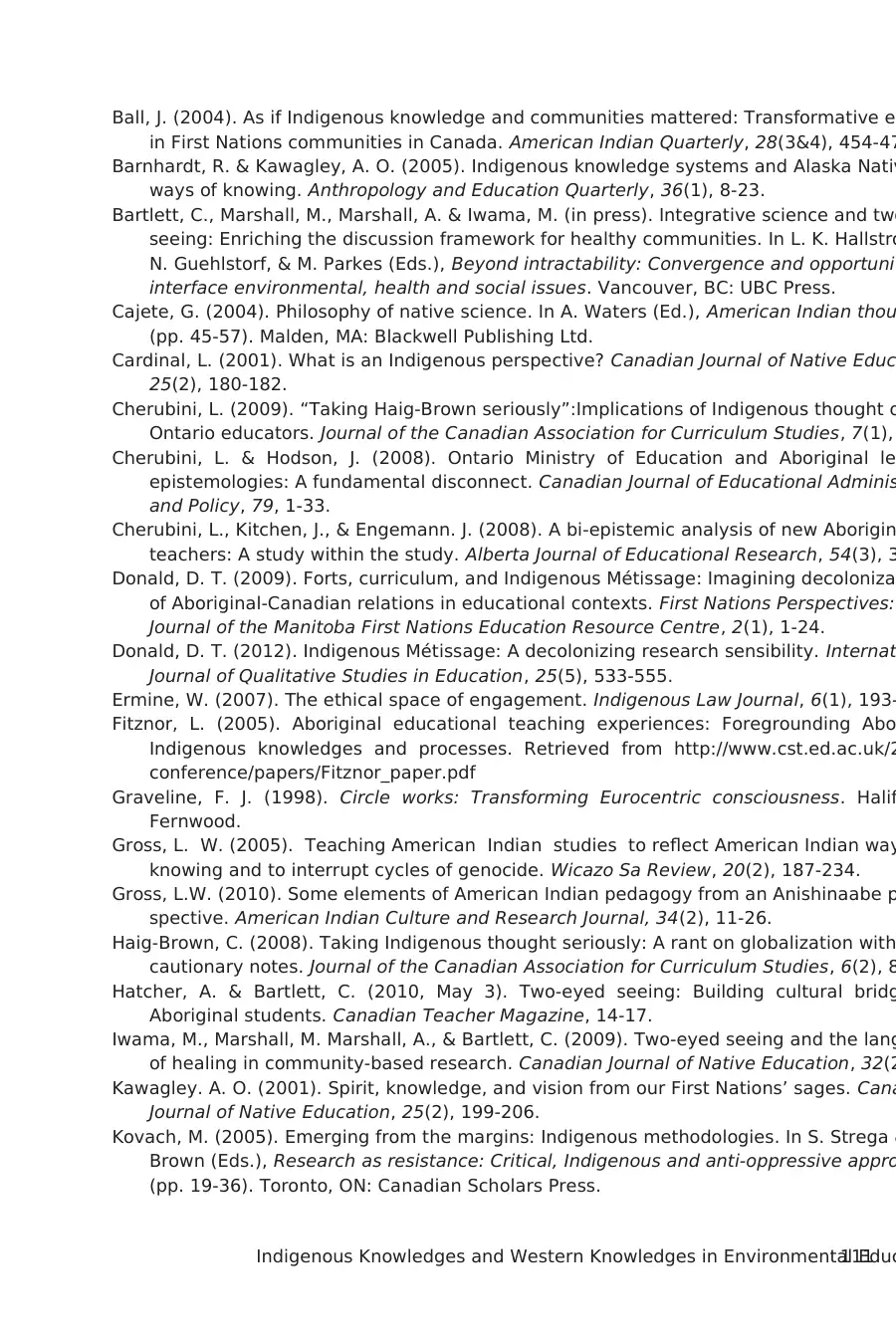
111Indigenous Knowledges and Western Knowledges in Environmental Educ
Ball, J. (2004). As if Indigenous knowledge and communities mattered: Transformative ed
in First Nations communities in Canada. American Indian Quarterly, 28(3&4), 454-47
Barnhardt, R. & Kawagley, A. O. (2005). Indigenous knowledge systems and Alaska Nativ
ways of knowing. Anthropology and Education Quarterly, 36(1), 8-23.
Bartlett, C., Marshall, M., Marshall, A. & Iwama, M. (in press). Integrative science and two
seeing: Enriching the discussion framework for healthy communities. In L. K. Hallstro
N. Guehlstorf, & M. Parkes (Eds.), Beyond intractability: Convergence and opportunit
interface environmental, health and social issues. Vancouver, BC: UBC Press.
Cajete, G. (2004). Philosophy of native science. In A. Waters (Ed.), American Indian thou
(pp. 45-57). Malden, MA: Blackwell Publishing Ltd.
Cardinal, L. (2001). What is an Indigenous perspective? Canadian Journal of Native Educ
25(2), 180-182.
Cherubini, L. (2009). “Taking Haig-Brown seriously”:Implications of Indigenous thought o
Ontario educators. Journal of the Canadian Association for Curriculum Studies, 7(1),
Cherubini, L. & Hodson, J. (2008). Ontario Ministry of Education and Aboriginal le
epistemologies: A fundamental disconnect. Canadian Journal of Educational Adminis
and Policy, 79, 1-33.
Cherubini, L., Kitchen, J., & Engemann. J. (2008). A bi-epistemic analysis of new Aborigin
teachers: A study within the study. Alberta Journal of Educational Research, 54(3), 3
Donald, D. T. (2009). Forts, curriculum, and Indigenous Métissage: Imagining decoloniza
of Aboriginal-Canadian relations in educational contexts. First Nations Perspectives:
Journal of the Manitoba First Nations Education Resource Centre, 2(1), 1-24.
Donald, D. T. (2012). Indigenous Métissage: A decolonizing research sensibility. Internat
Journal of Qualitative Studies in Education, 25(5), 533-555.
Ermine, W. (2007). The ethical space of engagement. Indigenous Law Journal, 6(1), 193-
Fitznor, L. (2005). Aboriginal educational teaching experiences: Foregrounding Abo
Indigenous knowledges and processes. Retrieved from http://www.cst.ed.ac.uk/2
conference/papers/Fitznor_paper.pdf
Graveline, F. J. (1998). Circle works: Transforming Eurocentric consciousness. Halif
Fernwood.
Gross, L. W. (2005). Teaching American Indian studies to reflect American Indian way
knowing and to interrupt cycles of genocide. Wicazo Sa Review, 20(2), 187-234.
Gross, L.W. (2010). Some elements of American Indian pedagogy from an Anishinaabe p
spective. American Indian Culture and Research Journal, 34(2), 11-26.
Haig-Brown, C. (2008). Taking Indigenous thought seriously: A rant on globalization with
cautionary notes. Journal of the Canadian Association for Curriculum Studies, 6(2), 8
Hatcher, A. & Bartlett, C. (2010, May 3). Two-eyed seeing: Building cultural bridg
Aboriginal students. Canadian Teacher Magazine, 14-17.
Iwama, M., Marshall, M. Marshall, A., & Bartlett, C. (2009). Two-eyed seeing and the lang
of healing in community-based research. Canadian Journal of Native Education, 32(2
Kawagley. A. O. (2001). Spirit, knowledge, and vision from our First Nations’ sages. Cana
Journal of Native Education, 25(2), 199-206.
Kovach, M. (2005). Emerging from the margins: Indigenous methodologies. In S. Strega &
Brown (Eds.), Research as resistance: Critical, Indigenous and anti-oppressive appro
(pp. 19-36). Toronto, ON: Canadian Scholars Press.
Ball, J. (2004). As if Indigenous knowledge and communities mattered: Transformative ed
in First Nations communities in Canada. American Indian Quarterly, 28(3&4), 454-47
Barnhardt, R. & Kawagley, A. O. (2005). Indigenous knowledge systems and Alaska Nativ
ways of knowing. Anthropology and Education Quarterly, 36(1), 8-23.
Bartlett, C., Marshall, M., Marshall, A. & Iwama, M. (in press). Integrative science and two
seeing: Enriching the discussion framework for healthy communities. In L. K. Hallstro
N. Guehlstorf, & M. Parkes (Eds.), Beyond intractability: Convergence and opportunit
interface environmental, health and social issues. Vancouver, BC: UBC Press.
Cajete, G. (2004). Philosophy of native science. In A. Waters (Ed.), American Indian thou
(pp. 45-57). Malden, MA: Blackwell Publishing Ltd.
Cardinal, L. (2001). What is an Indigenous perspective? Canadian Journal of Native Educ
25(2), 180-182.
Cherubini, L. (2009). “Taking Haig-Brown seriously”:Implications of Indigenous thought o
Ontario educators. Journal of the Canadian Association for Curriculum Studies, 7(1),
Cherubini, L. & Hodson, J. (2008). Ontario Ministry of Education and Aboriginal le
epistemologies: A fundamental disconnect. Canadian Journal of Educational Adminis
and Policy, 79, 1-33.
Cherubini, L., Kitchen, J., & Engemann. J. (2008). A bi-epistemic analysis of new Aborigin
teachers: A study within the study. Alberta Journal of Educational Research, 54(3), 3
Donald, D. T. (2009). Forts, curriculum, and Indigenous Métissage: Imagining decoloniza
of Aboriginal-Canadian relations in educational contexts. First Nations Perspectives:
Journal of the Manitoba First Nations Education Resource Centre, 2(1), 1-24.
Donald, D. T. (2012). Indigenous Métissage: A decolonizing research sensibility. Internat
Journal of Qualitative Studies in Education, 25(5), 533-555.
Ermine, W. (2007). The ethical space of engagement. Indigenous Law Journal, 6(1), 193-
Fitznor, L. (2005). Aboriginal educational teaching experiences: Foregrounding Abo
Indigenous knowledges and processes. Retrieved from http://www.cst.ed.ac.uk/2
conference/papers/Fitznor_paper.pdf
Graveline, F. J. (1998). Circle works: Transforming Eurocentric consciousness. Halif
Fernwood.
Gross, L. W. (2005). Teaching American Indian studies to reflect American Indian way
knowing and to interrupt cycles of genocide. Wicazo Sa Review, 20(2), 187-234.
Gross, L.W. (2010). Some elements of American Indian pedagogy from an Anishinaabe p
spective. American Indian Culture and Research Journal, 34(2), 11-26.
Haig-Brown, C. (2008). Taking Indigenous thought seriously: A rant on globalization with
cautionary notes. Journal of the Canadian Association for Curriculum Studies, 6(2), 8
Hatcher, A. & Bartlett, C. (2010, May 3). Two-eyed seeing: Building cultural bridg
Aboriginal students. Canadian Teacher Magazine, 14-17.
Iwama, M., Marshall, M. Marshall, A., & Bartlett, C. (2009). Two-eyed seeing and the lang
of healing in community-based research. Canadian Journal of Native Education, 32(2
Kawagley. A. O. (2001). Spirit, knowledge, and vision from our First Nations’ sages. Cana
Journal of Native Education, 25(2), 199-206.
Kovach, M. (2005). Emerging from the margins: Indigenous methodologies. In S. Strega &
Brown (Eds.), Research as resistance: Critical, Indigenous and anti-oppressive appro
(pp. 19-36). Toronto, ON: Canadian Scholars Press.
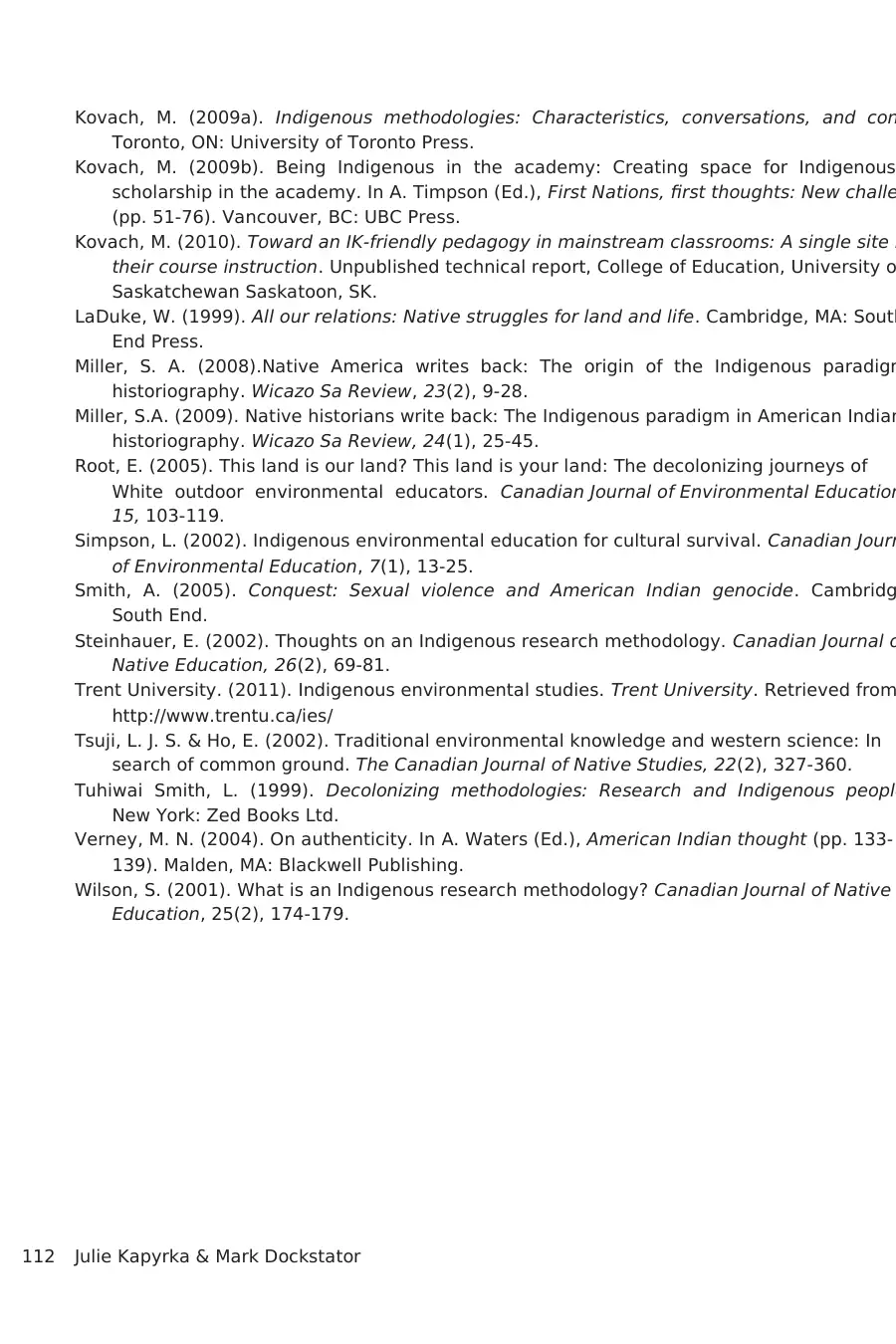
112 Julie Kapyrka & Mark Dockstator
Kovach, M. (2009a). Indigenous methodologies: Characteristics, conversations, and con
Toronto, ON: University of Toronto Press.
Kovach, M. (2009b). Being Indigenous in the academy: Creating space for Indigenous
scholarship in the academy. In A. Timpson (Ed.), First Nations, first thoughts: New challe
(pp. 51-76). Vancouver, BC: UBC Press.
Kovach, M. (2010). Toward an IK-friendly pedagogy in mainstream classrooms: A single site i
their course instruction. Unpublished technical report, College of Education, University o
Saskatchewan Saskatoon, SK.
LaDuke, W. (1999). All our relations: Native struggles for land and life. Cambridge, MA: South
End Press.
Miller, S. A. (2008).Native America writes back: The origin of the Indigenous paradigm
historiography. Wicazo Sa Review, 23(2), 9-28.
Miller, S.A. (2009). Native historians write back: The Indigenous paradigm in American Indian
historiography. Wicazo Sa Review, 24(1), 25-45.
Root, E. (2005). This land is our land? This land is your land: The decolonizing journeys of
White outdoor environmental educators. Canadian Journal of Environmental Education
15, 103-119.
Simpson, L. (2002). Indigenous environmental education for cultural survival. Canadian Journ
of Environmental Education, 7(1), 13-25.
Smith, A. (2005). Conquest: Sexual violence and American Indian genocide. Cambridg
South End.
Steinhauer, E. (2002). Thoughts on an Indigenous research methodology. Canadian Journal o
Native Education, 26(2), 69-81.
Trent University. (2011). Indigenous environmental studies. Trent University. Retrieved from
http://www.trentu.ca/ies/
Tsuji, L. J. S. & Ho, E. (2002). Traditional environmental knowledge and western science: In
search of common ground. The Canadian Journal of Native Studies, 22(2), 327-360.
Tuhiwai Smith, L. (1999). Decolonizing methodologies: Research and Indigenous people
New York: Zed Books Ltd.
Verney, M. N. (2004). On authenticity. In A. Waters (Ed.), American Indian thought (pp. 133-
139). Malden, MA: Blackwell Publishing.
Wilson, S. (2001). What is an Indigenous research methodology? Canadian Journal of Native
Education, 25(2), 174-179.
Kovach, M. (2009a). Indigenous methodologies: Characteristics, conversations, and con
Toronto, ON: University of Toronto Press.
Kovach, M. (2009b). Being Indigenous in the academy: Creating space for Indigenous
scholarship in the academy. In A. Timpson (Ed.), First Nations, first thoughts: New challe
(pp. 51-76). Vancouver, BC: UBC Press.
Kovach, M. (2010). Toward an IK-friendly pedagogy in mainstream classrooms: A single site i
their course instruction. Unpublished technical report, College of Education, University o
Saskatchewan Saskatoon, SK.
LaDuke, W. (1999). All our relations: Native struggles for land and life. Cambridge, MA: South
End Press.
Miller, S. A. (2008).Native America writes back: The origin of the Indigenous paradigm
historiography. Wicazo Sa Review, 23(2), 9-28.
Miller, S.A. (2009). Native historians write back: The Indigenous paradigm in American Indian
historiography. Wicazo Sa Review, 24(1), 25-45.
Root, E. (2005). This land is our land? This land is your land: The decolonizing journeys of
White outdoor environmental educators. Canadian Journal of Environmental Education
15, 103-119.
Simpson, L. (2002). Indigenous environmental education for cultural survival. Canadian Journ
of Environmental Education, 7(1), 13-25.
Smith, A. (2005). Conquest: Sexual violence and American Indian genocide. Cambridg
South End.
Steinhauer, E. (2002). Thoughts on an Indigenous research methodology. Canadian Journal o
Native Education, 26(2), 69-81.
Trent University. (2011). Indigenous environmental studies. Trent University. Retrieved from
http://www.trentu.ca/ies/
Tsuji, L. J. S. & Ho, E. (2002). Traditional environmental knowledge and western science: In
search of common ground. The Canadian Journal of Native Studies, 22(2), 327-360.
Tuhiwai Smith, L. (1999). Decolonizing methodologies: Research and Indigenous people
New York: Zed Books Ltd.
Verney, M. N. (2004). On authenticity. In A. Waters (Ed.), American Indian thought (pp. 133-
139). Malden, MA: Blackwell Publishing.
Wilson, S. (2001). What is an Indigenous research methodology? Canadian Journal of Native
Education, 25(2), 174-179.
1 out of 16
Related Documents
Your All-in-One AI-Powered Toolkit for Academic Success.
+13062052269
info@desklib.com
Available 24*7 on WhatsApp / Email
![[object Object]](/_next/static/media/star-bottom.7253800d.svg)
Unlock your academic potential
© 2024 | Zucol Services PVT LTD | All rights reserved.